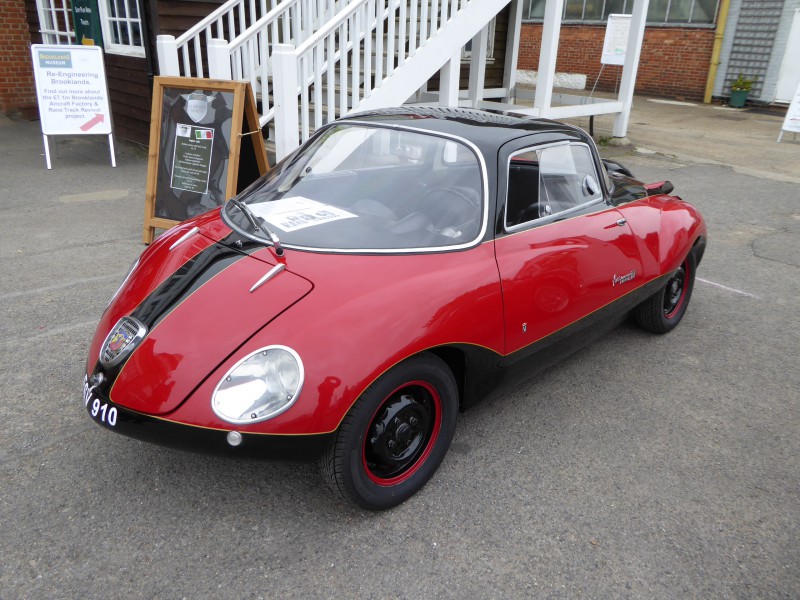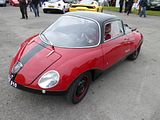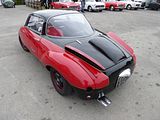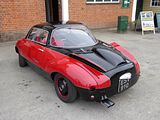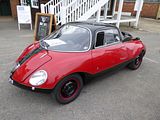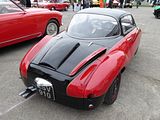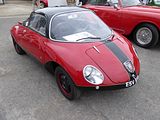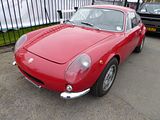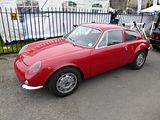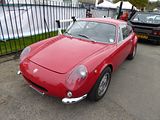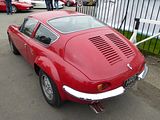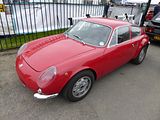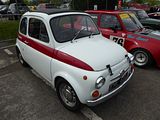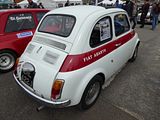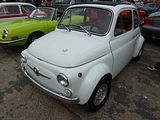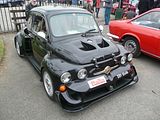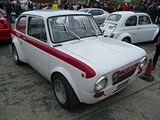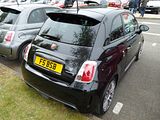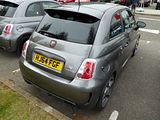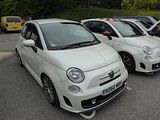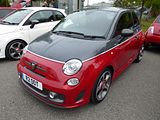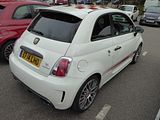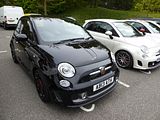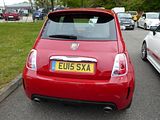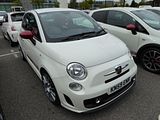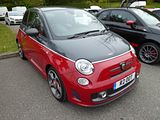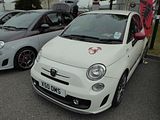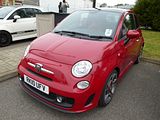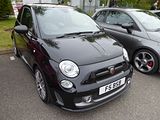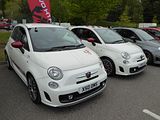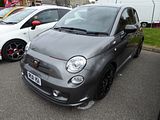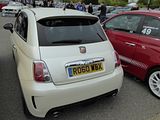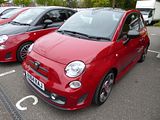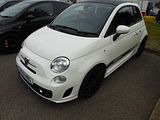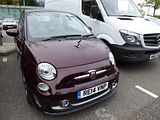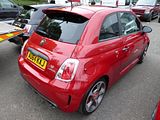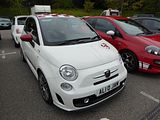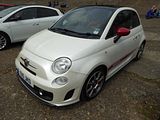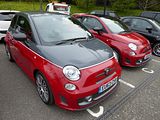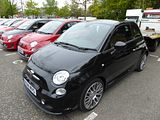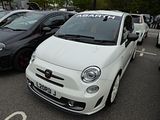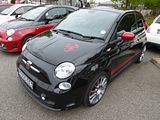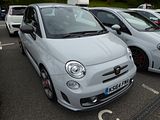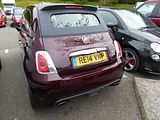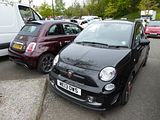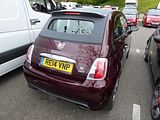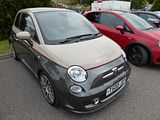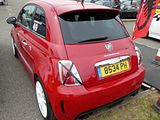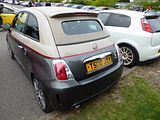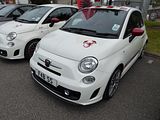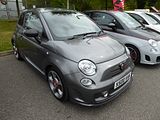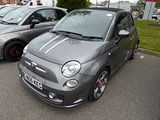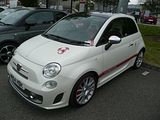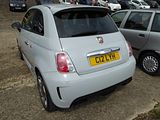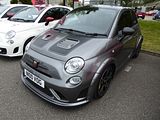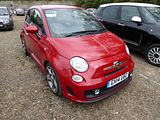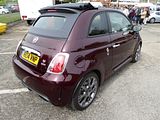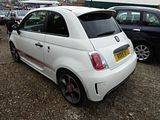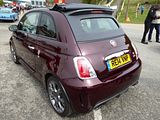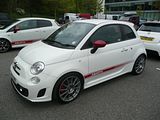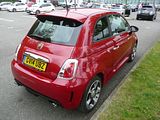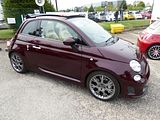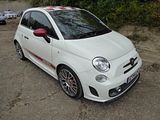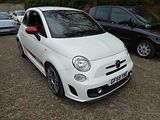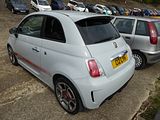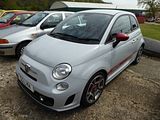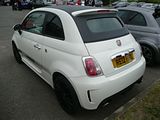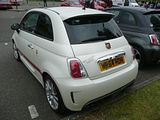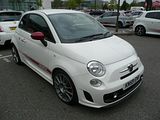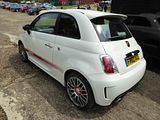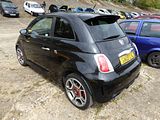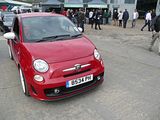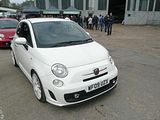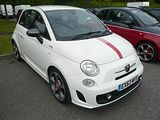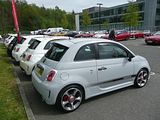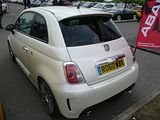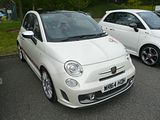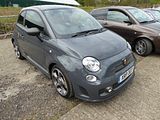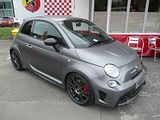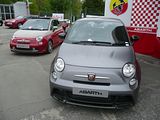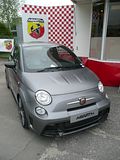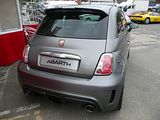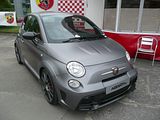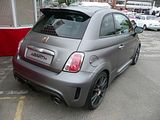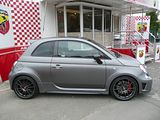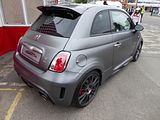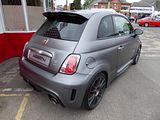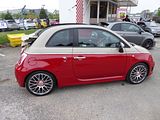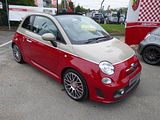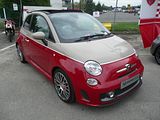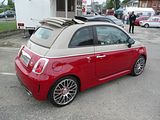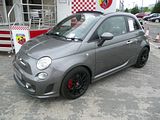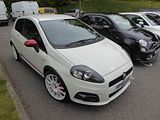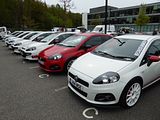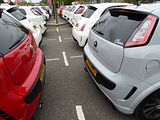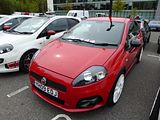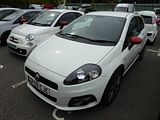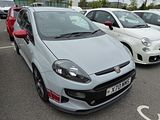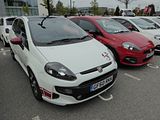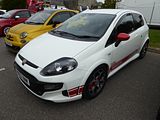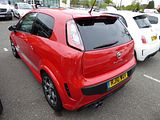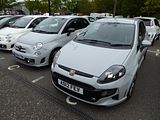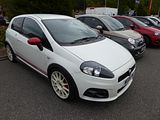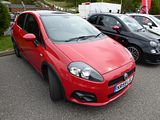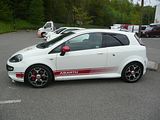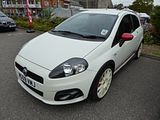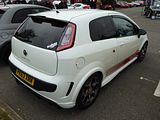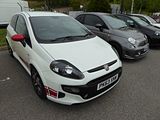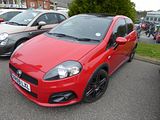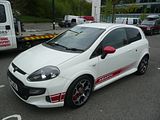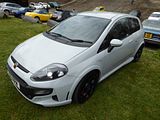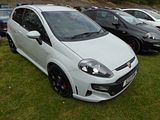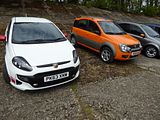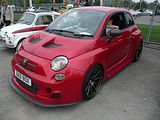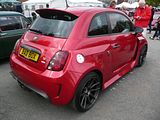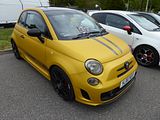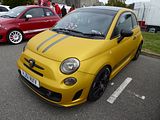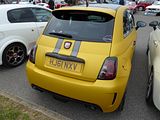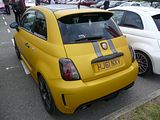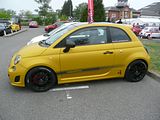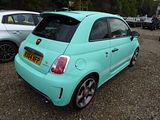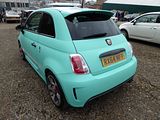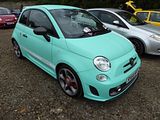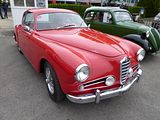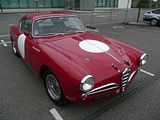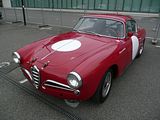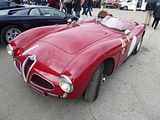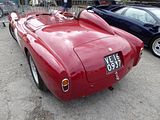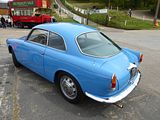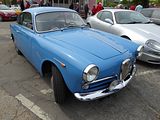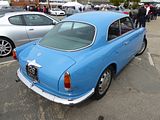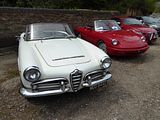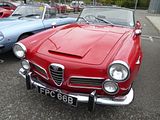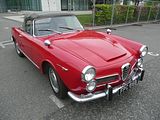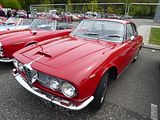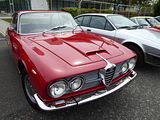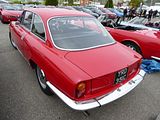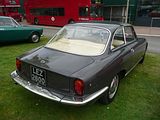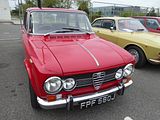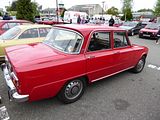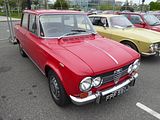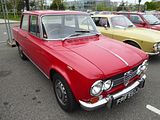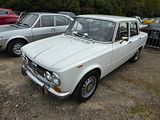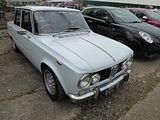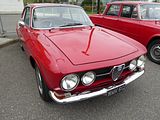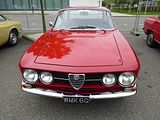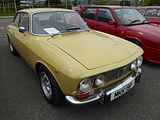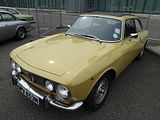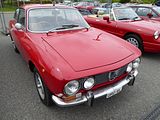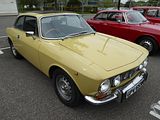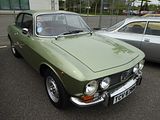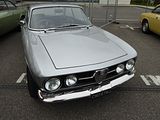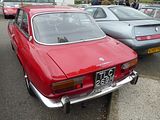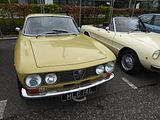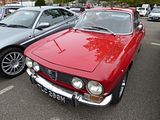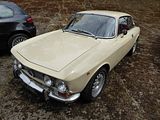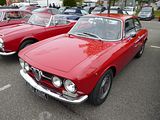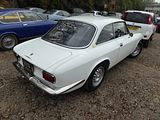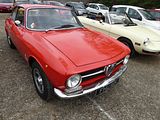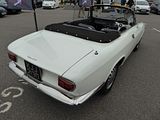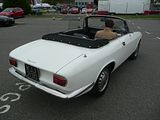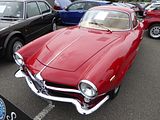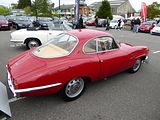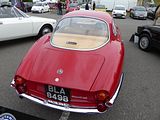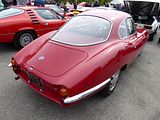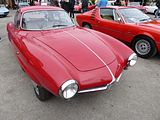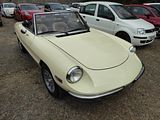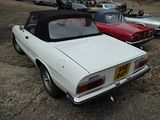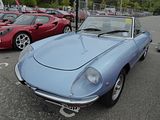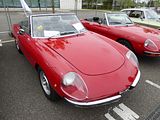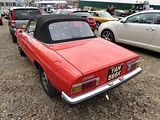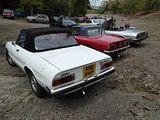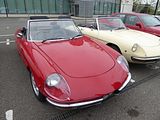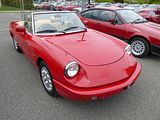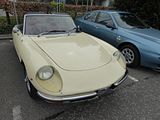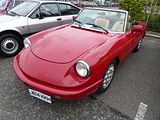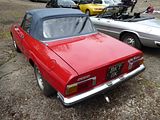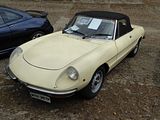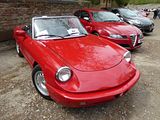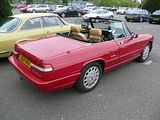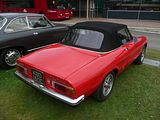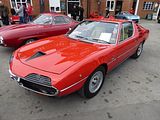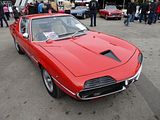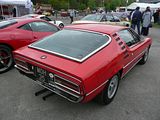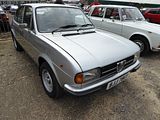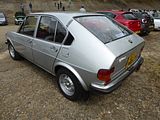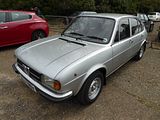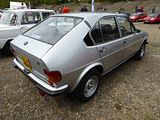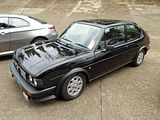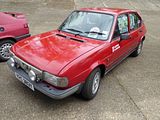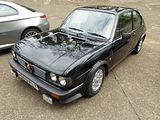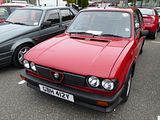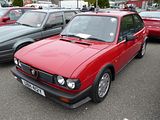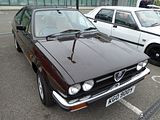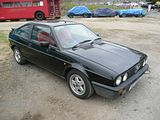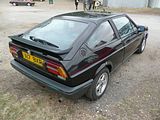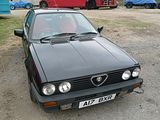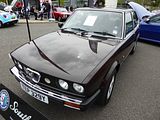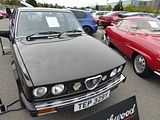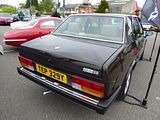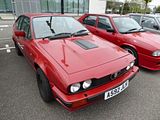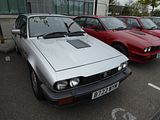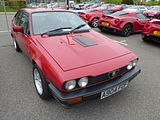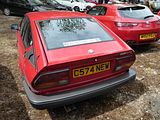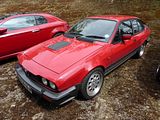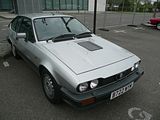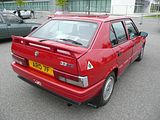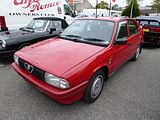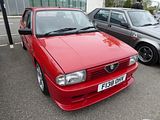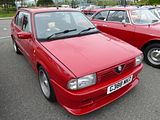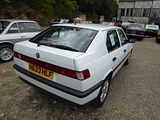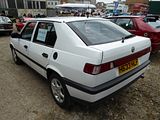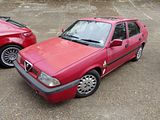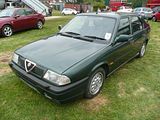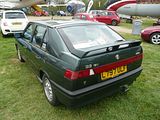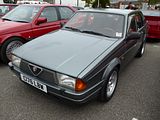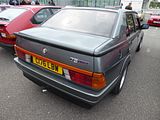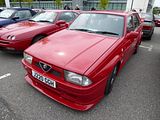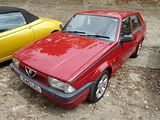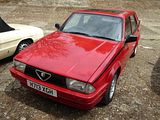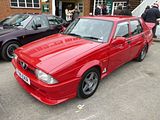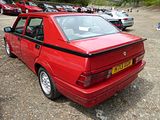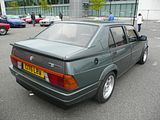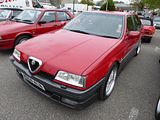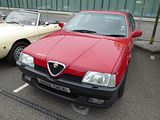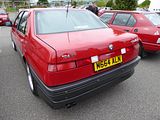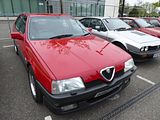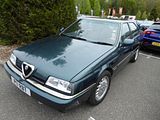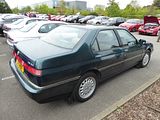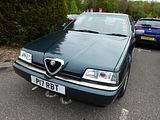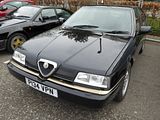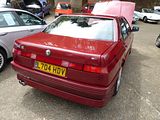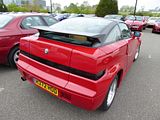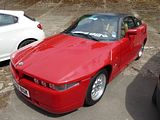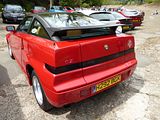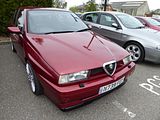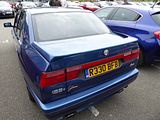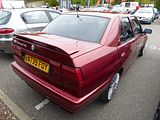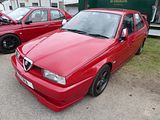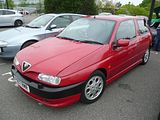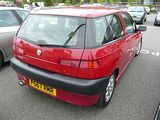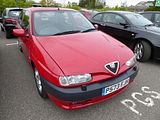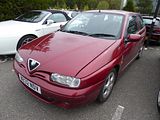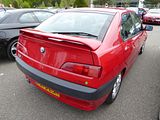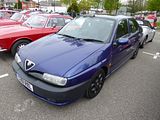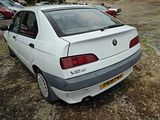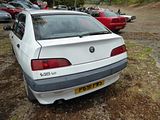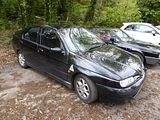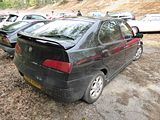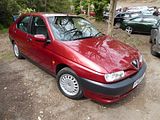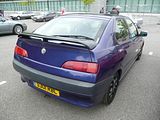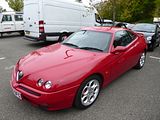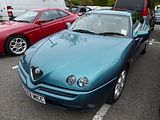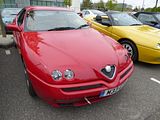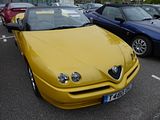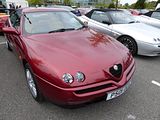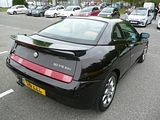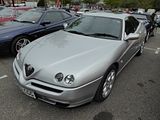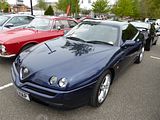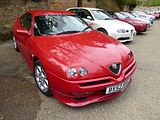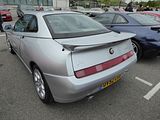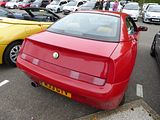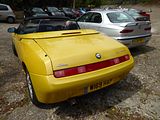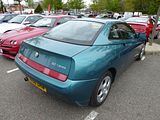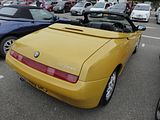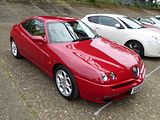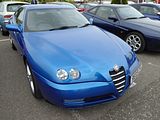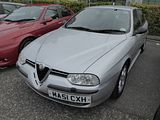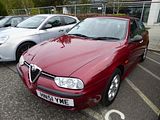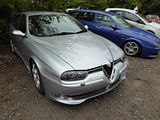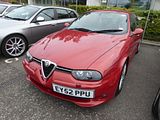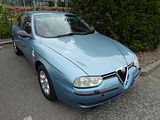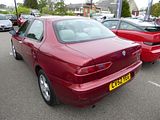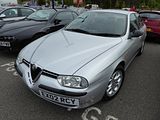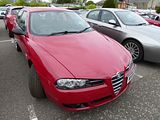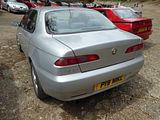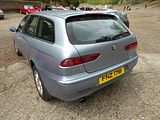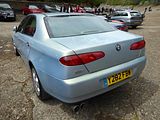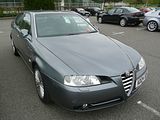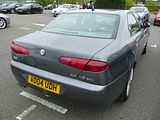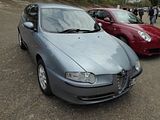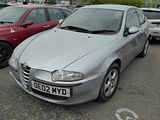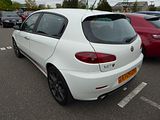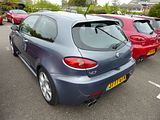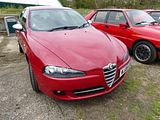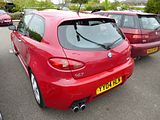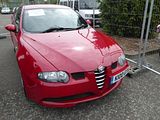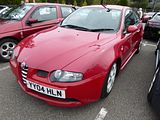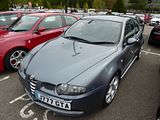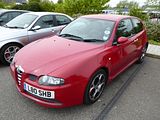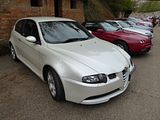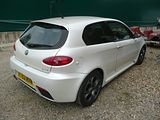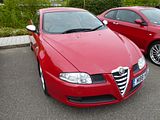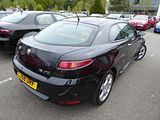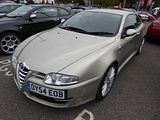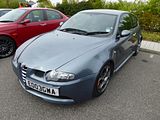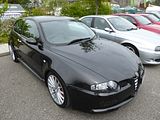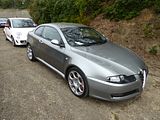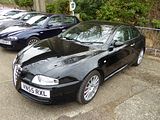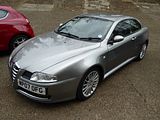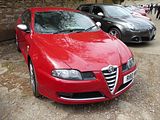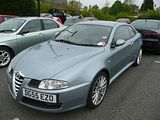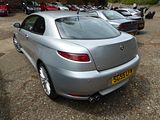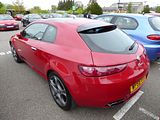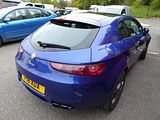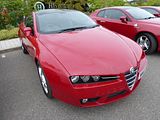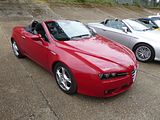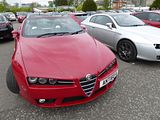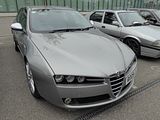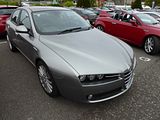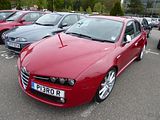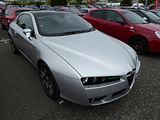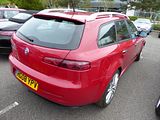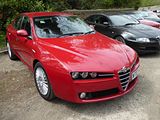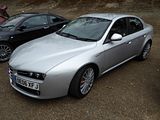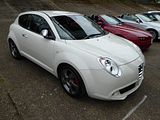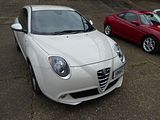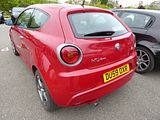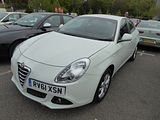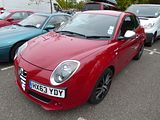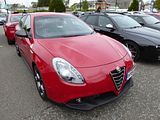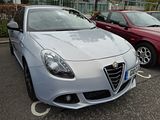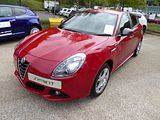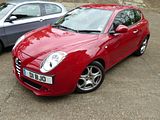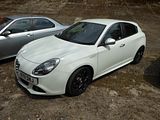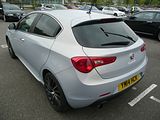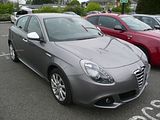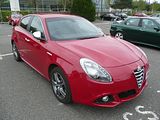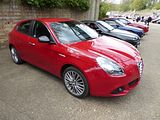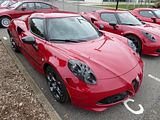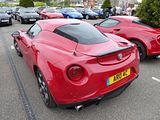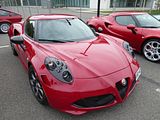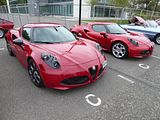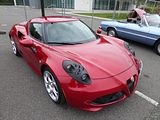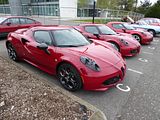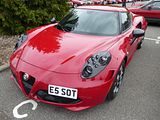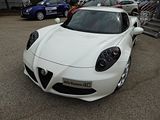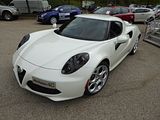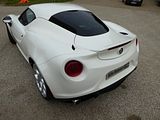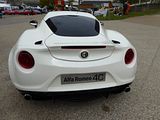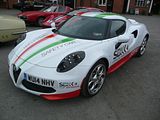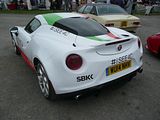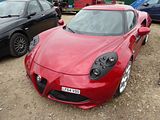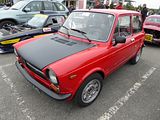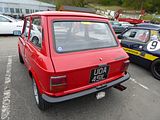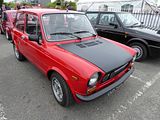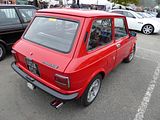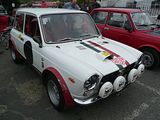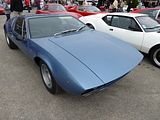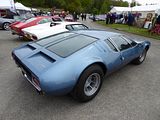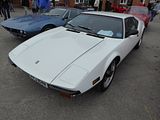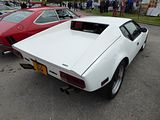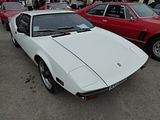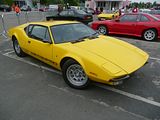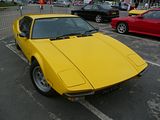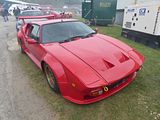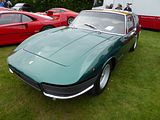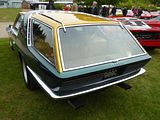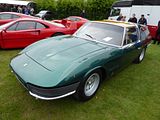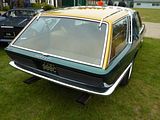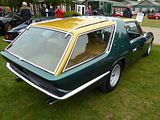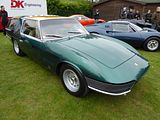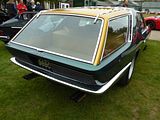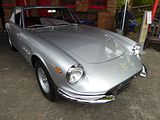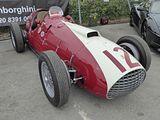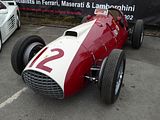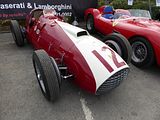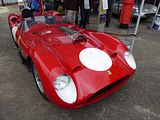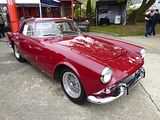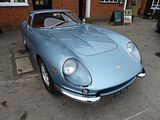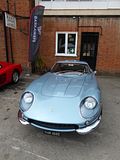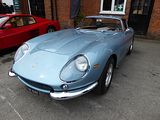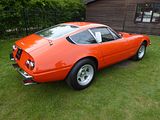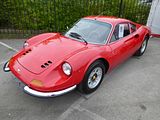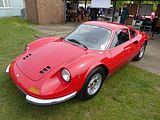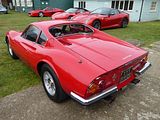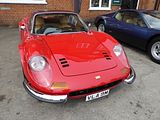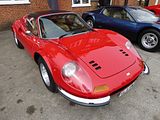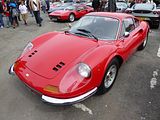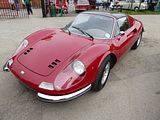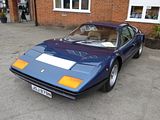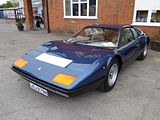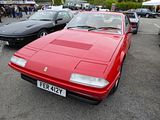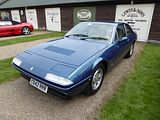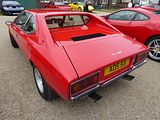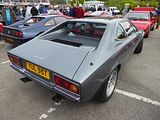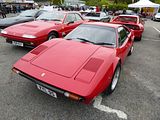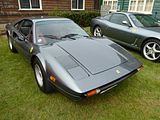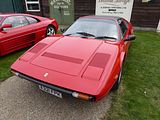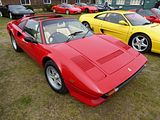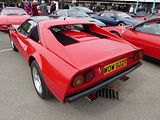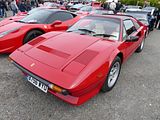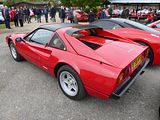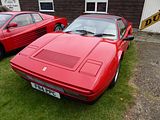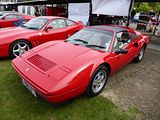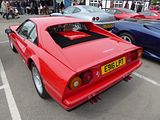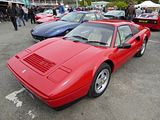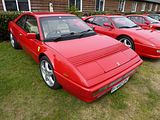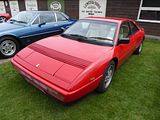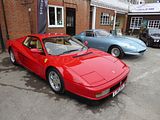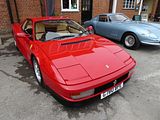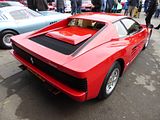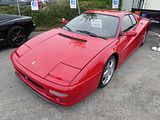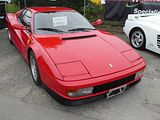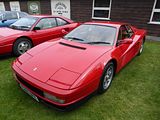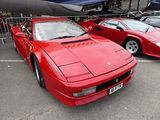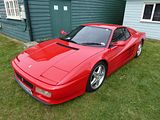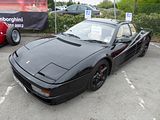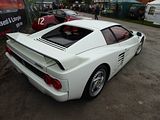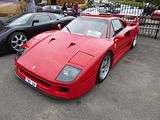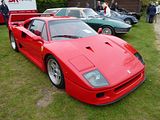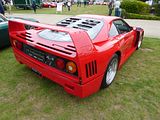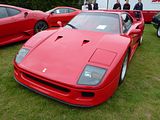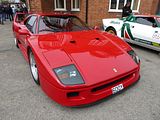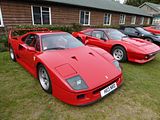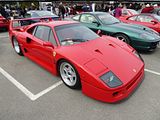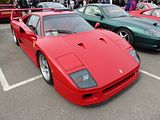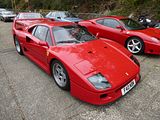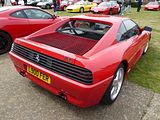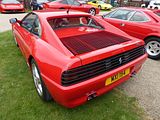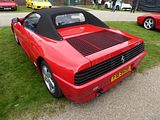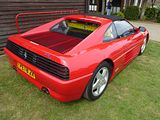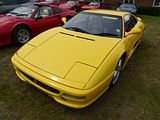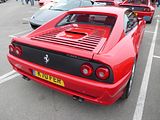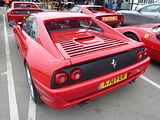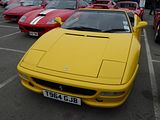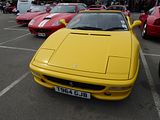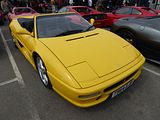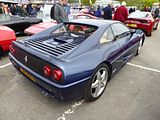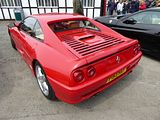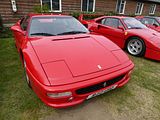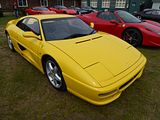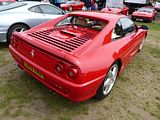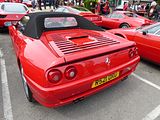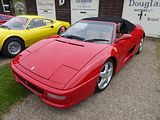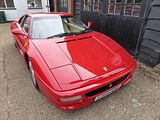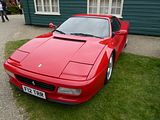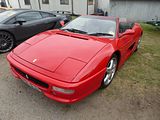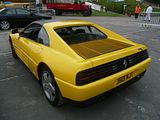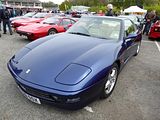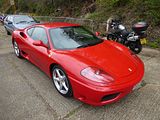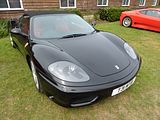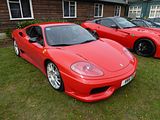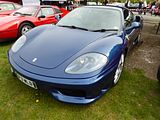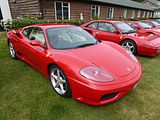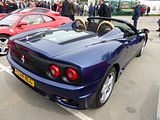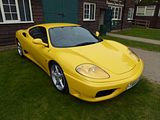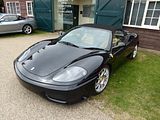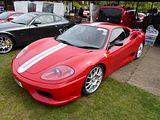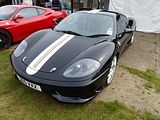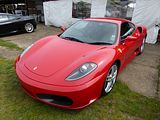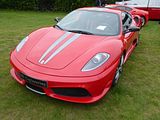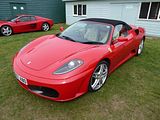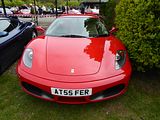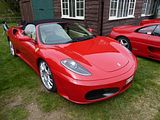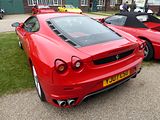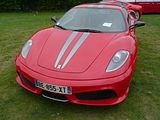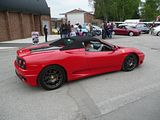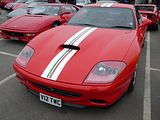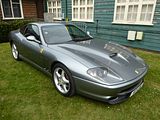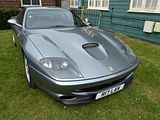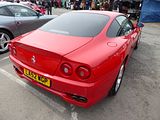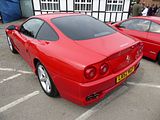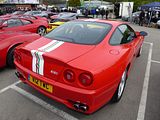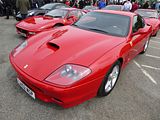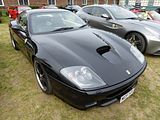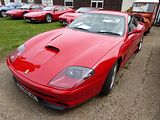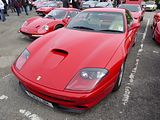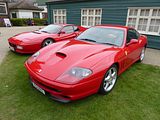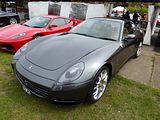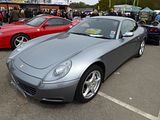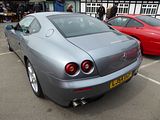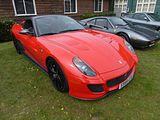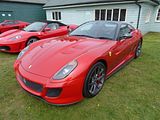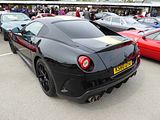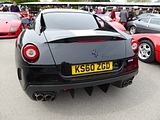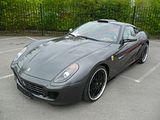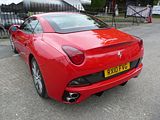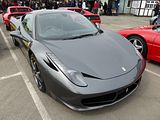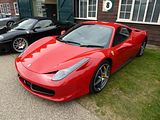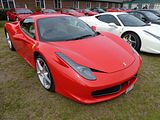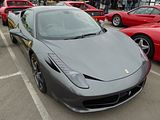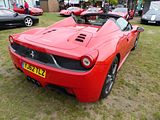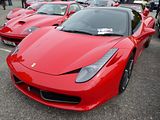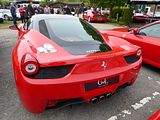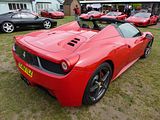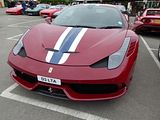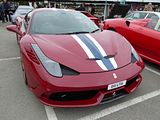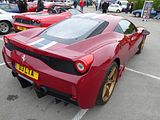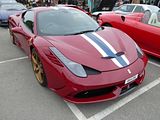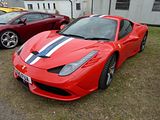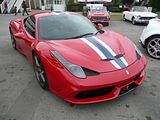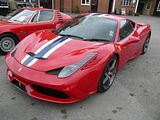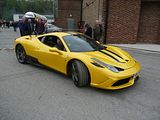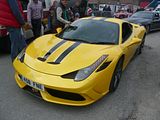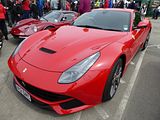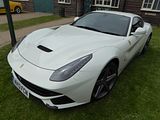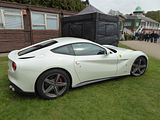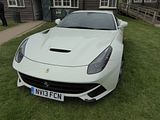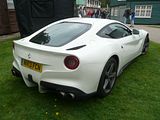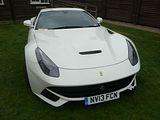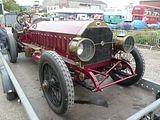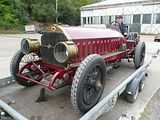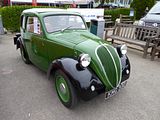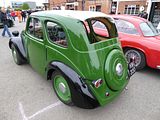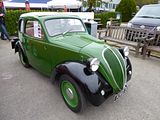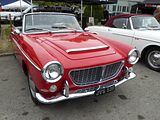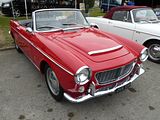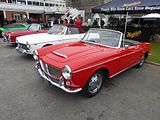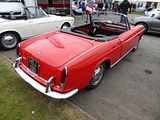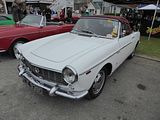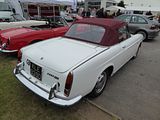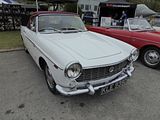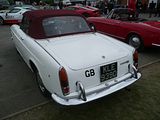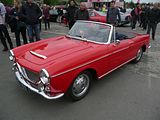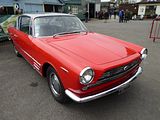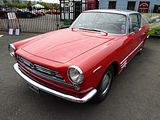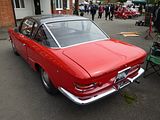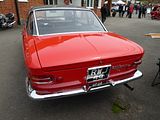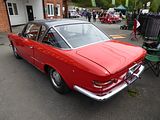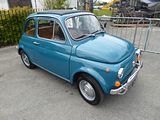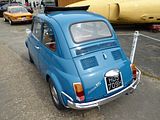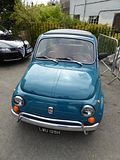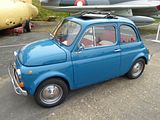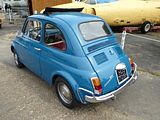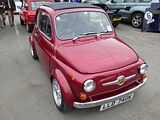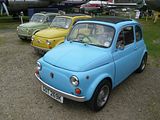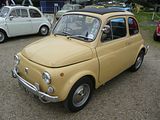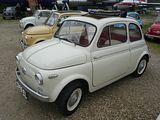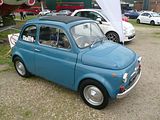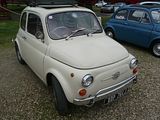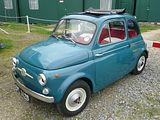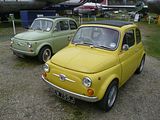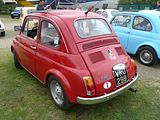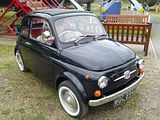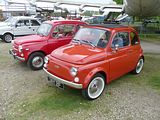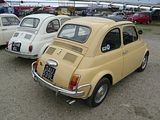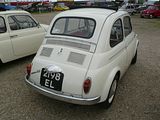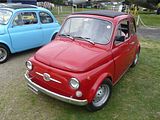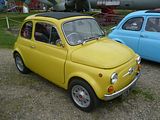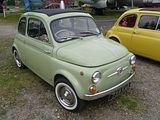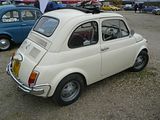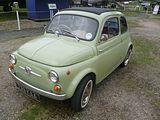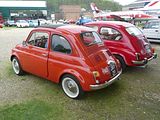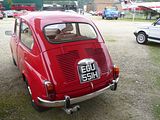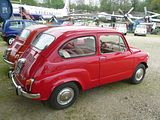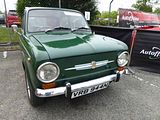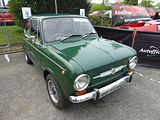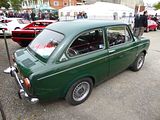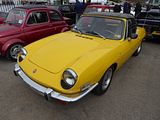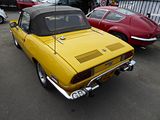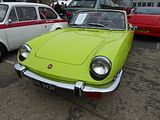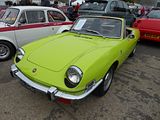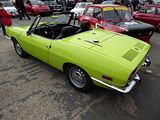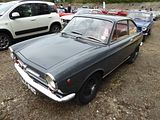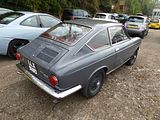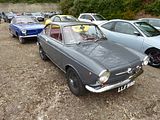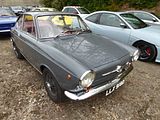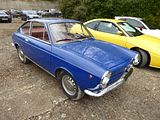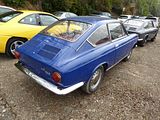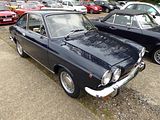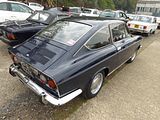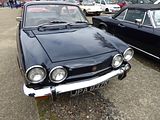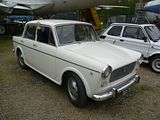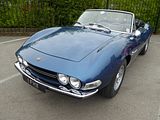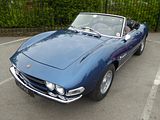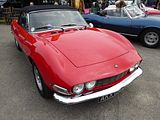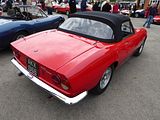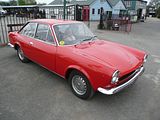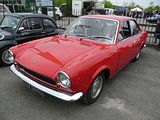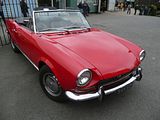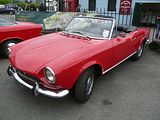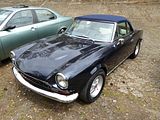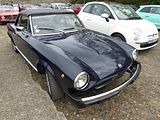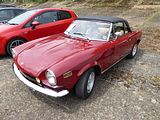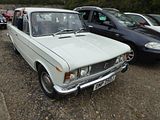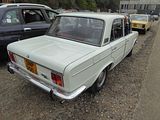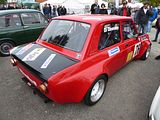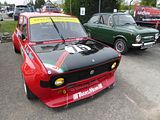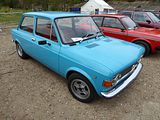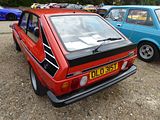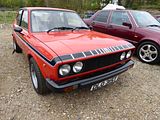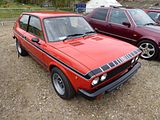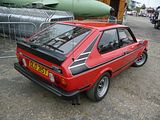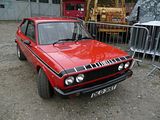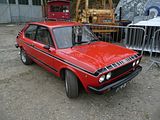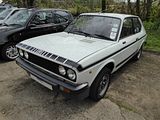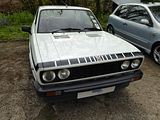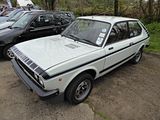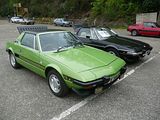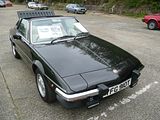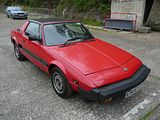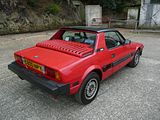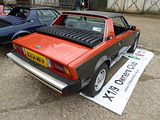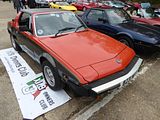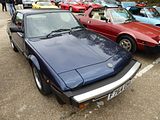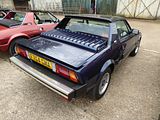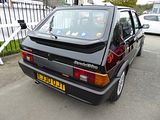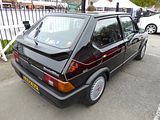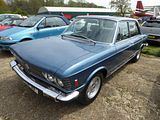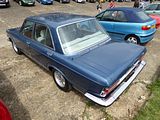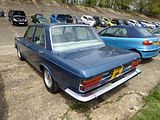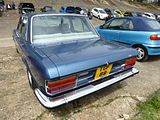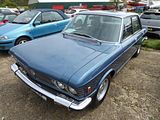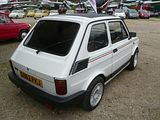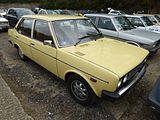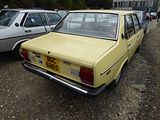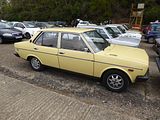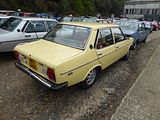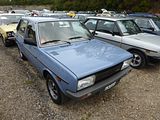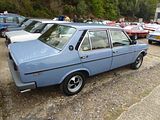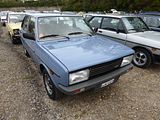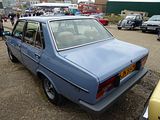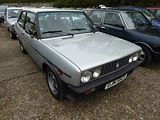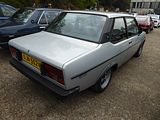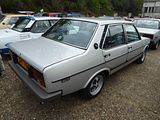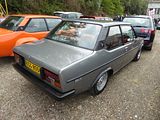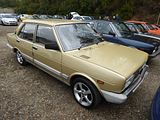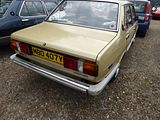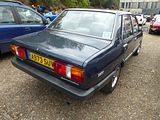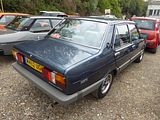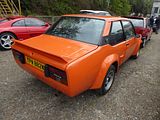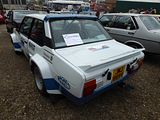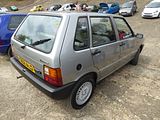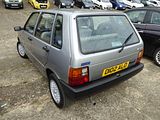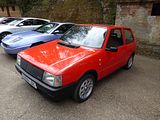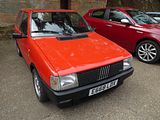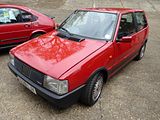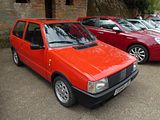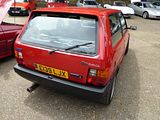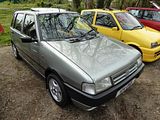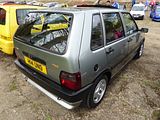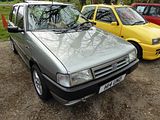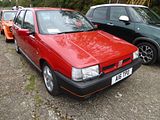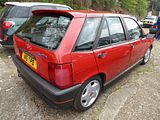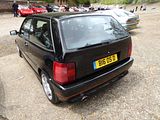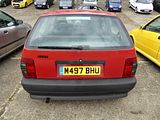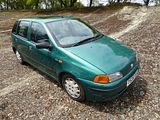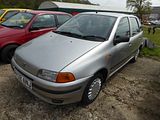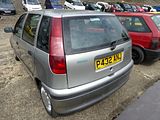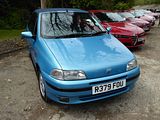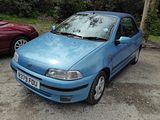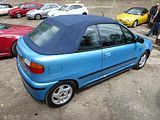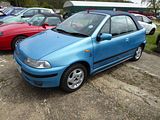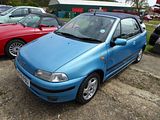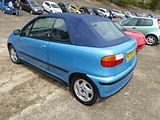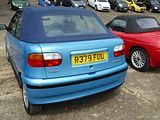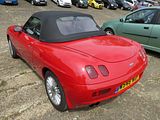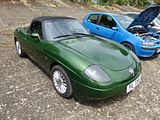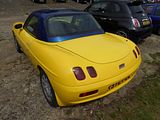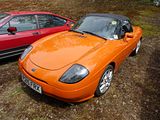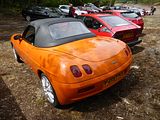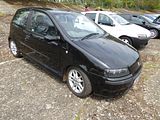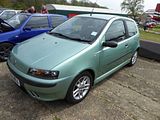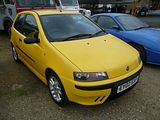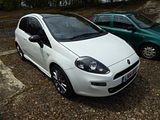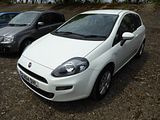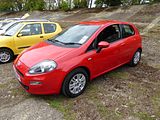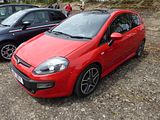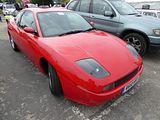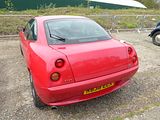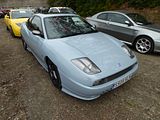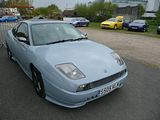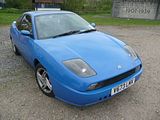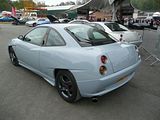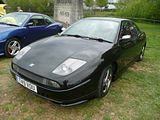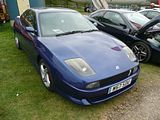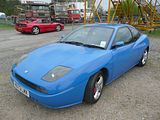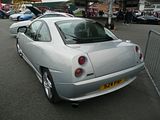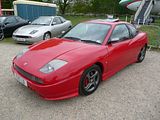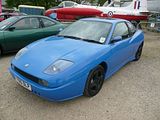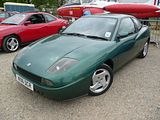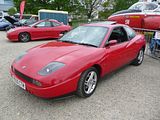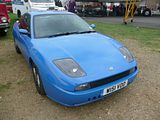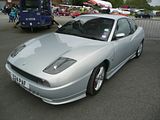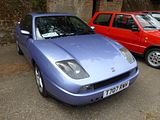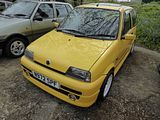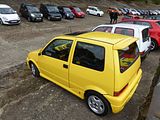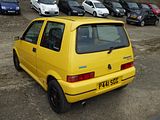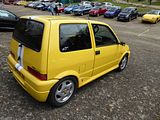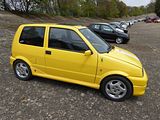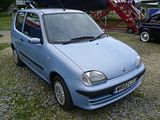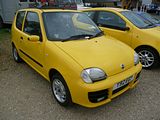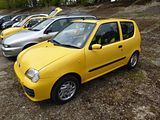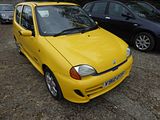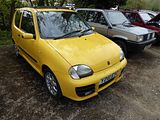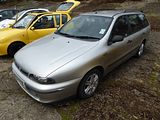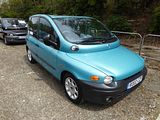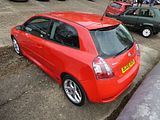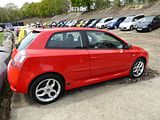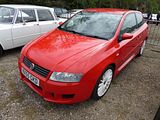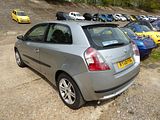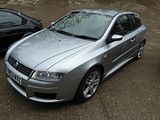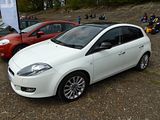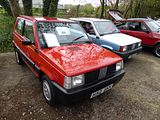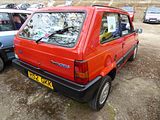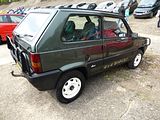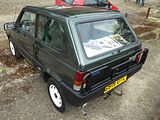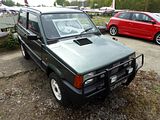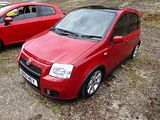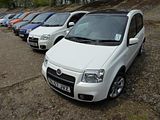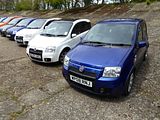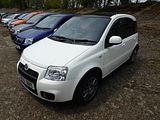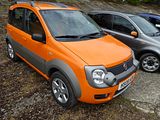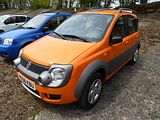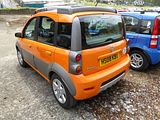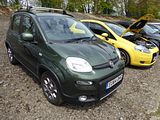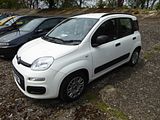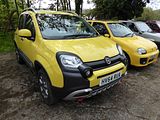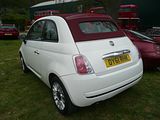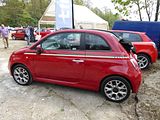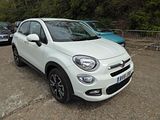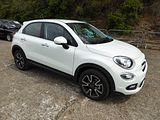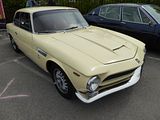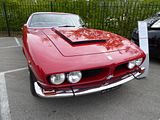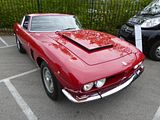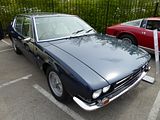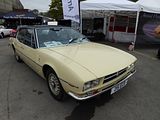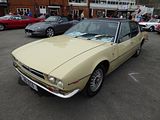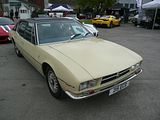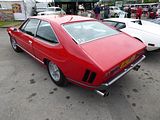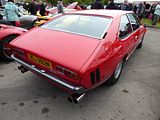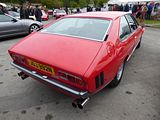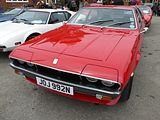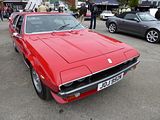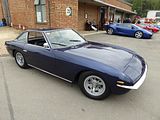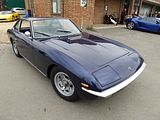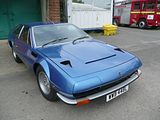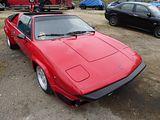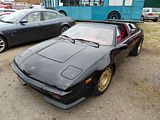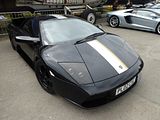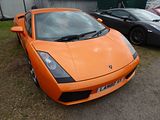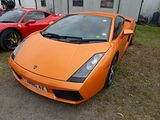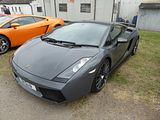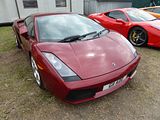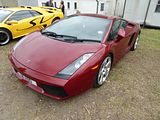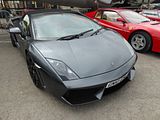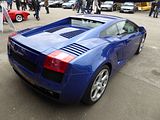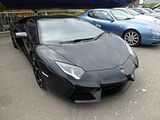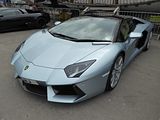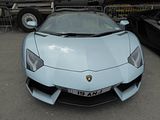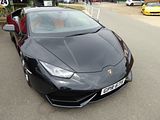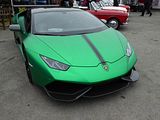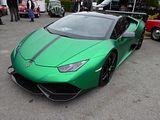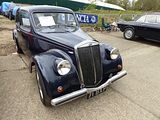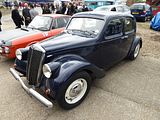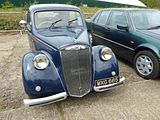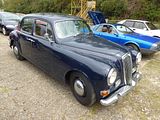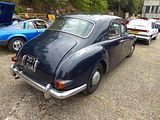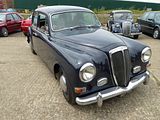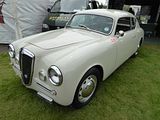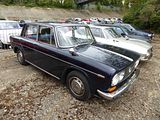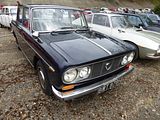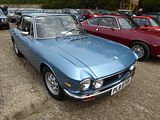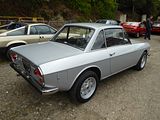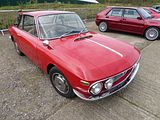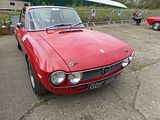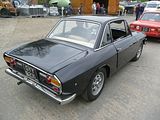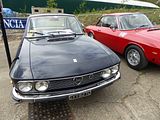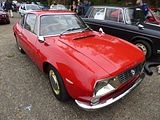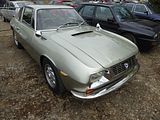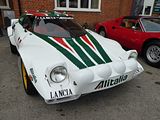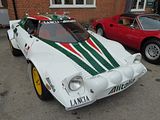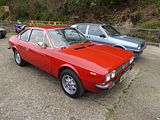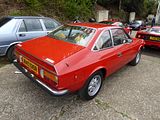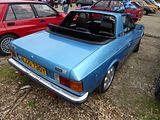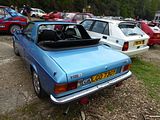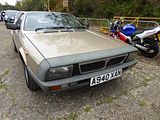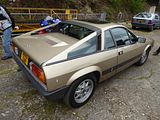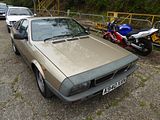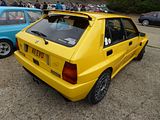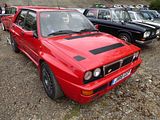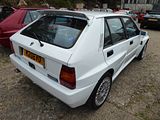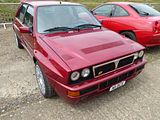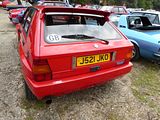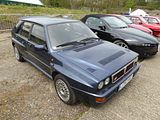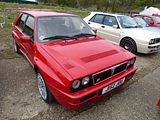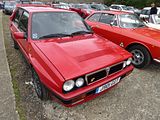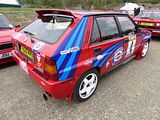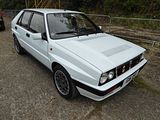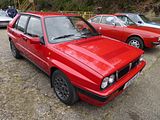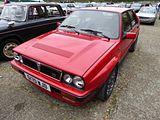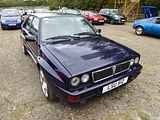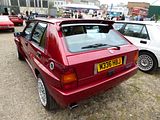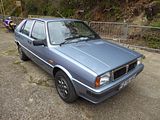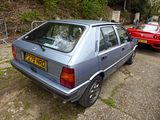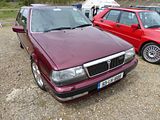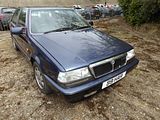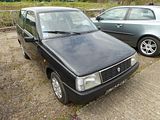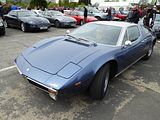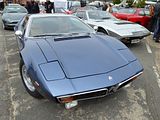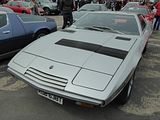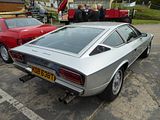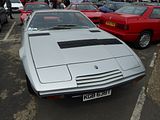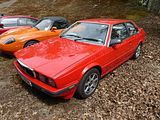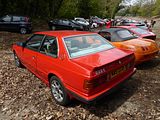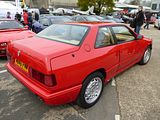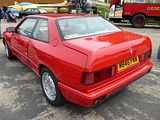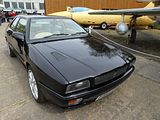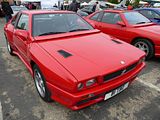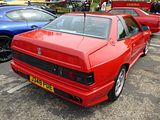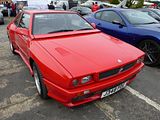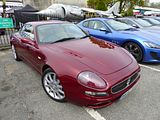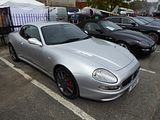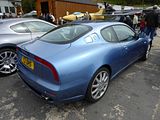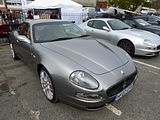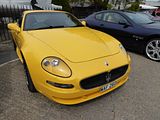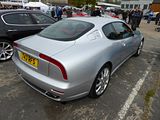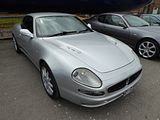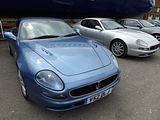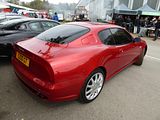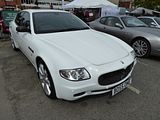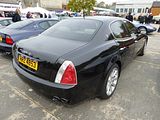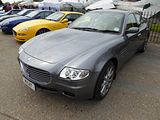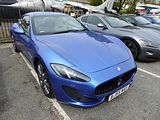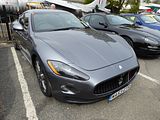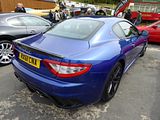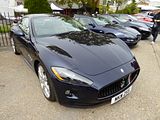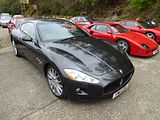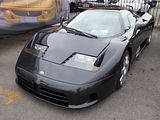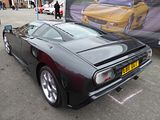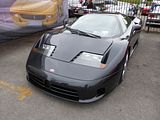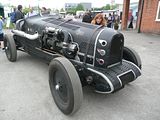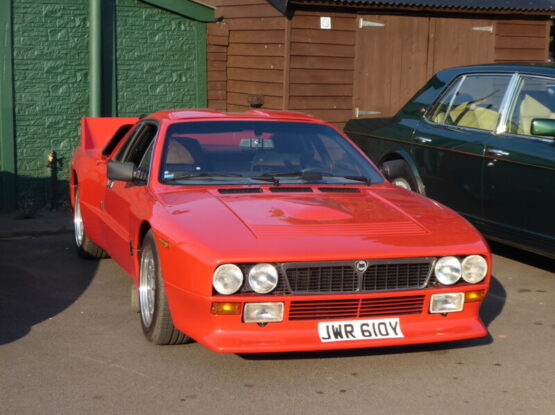After spending a long day at Brooklands, trying to see everything that was there, and catching up with my many friends, lovers of Italian cars, as well as fulfilling my Abarth Owners Club Event manager duties, as my friend Dan Grazier and I headed north to Donington for another gruelling day at the Historic Festival, a full report of which will be posted separately, the conversation in the car turned not so much as to what we had seen, but what we had not. The Brooklands Auto Italia, which has grown for humble beginnings when organiser Phil Ward managed to gather a small number of other Italian cars to go with the Fiat 124 Spider which he had recently bought and was so enjoying, has grown into the biggest gathering of Italian cars in the country, and if you want to see almost any Italian model made in the past 30 years, and quite a few that pre-date this, you can be pretty sure that there will be one or more examples somewhere in this historic location. After scratching our heads long and hard, we came up with a very short list, containing cars that are now down in many cases to single digit numbers of survivors. So, you won’t find a Fiat 127 in here, or Alfa’s Arna or 6, and slightly surprisingly nor is there a 116 Series Giulietta, Beta Saloon or a Gamma Coupe. But among the 1000 photos of cars that I took on the day, and included in this report, you will find just about anything else that was made by an Italian marque since the 1970s, and quite a few cars that you may not have seen for a long time, or indeed ever before. Make no mistake, this was a fantastic event, packed with some lovely cars, and a huge crowd who came to enjoy them. Prophecies of a wet day from our forecasters a few days out turned out to be a false alarm, and although it was not overtly sunny (the slight sunburn I experienced suggests the round yellow thing in the sky was trying to burst through the clouds!), so no effort, it seems, was spared, by enthusiastic owners in bringing their delights along for everyone’s enjoyment. Read on for the Italian automotive equivalent of a veritable banquet.
ABARTH
We’ll come to the modern Abarths shortly, but the most special car with a Scorpion badge on it for me, and I suspect many others, was nearly 60 years old, and was a car that I have only read about, and was not expecting to see in person. That’s because this 1957 Abarth 750 Sperimentale “Goccia”, which belongs to Delwyn Mallett, features from time to time in Octane magazine, as one of the “Long Term” cars, and I had recently read a couple of articles showing it somewhat dismantled as it underwent a rebuilt, and repaint. When Delwyn arrived with it, early in the morning, I could barely believe my eyes. Knowing it to be extremely rare, I was sure it would be his car. And so it turned out to be. He said that it had only been “finished” the night before, and actually there are still a few details to work on before it really is done. Like many Italian cars of the era, some of the key facts are unclear, so no-one knows for sure just how many of these were actually produced. The answer is certainly no more than 4, and it may be less than that. Delwyn has owned this car since 1984, having found it in Malta. The car dates from 1957, and sports a Vignale made body, styled by Giovanni Michelotti, that this well known Italian styling house produced in response to Carlo Abarth’s desire for something more aerodynamic to clothe the Fiat mechanicals that formed the basis of the cars he was tuning and racing, and which was intended to be capable of achieving a world speed record in its class. As was often the way, more than one styling house got invited to do the job, and the rival Zagato offering, that became the 750 Bialbero that we know and love won out and that was the car which was produced in some (it’s a relative term!) quantity, leaving this very distinctive design to remain an interesting concept. “Goccia” is the Italian for “rain drop”, and even now this is quite a futuristic looking shape. Like all Abarths of the era, it is tiny, and Delwyn says that it is also very noisy indeed, so you probably would not want to take it on a long journey, though of course these things did not get in the way of those who raced the little Scorpions in period.
The Goccia was not his only Abarth present. While he does not have a modern one, he does have 3 more classic models, or so he thought, when I asked. He had had a 5th, but remembered that he had sold that! He had got a friend to bring down another very rare car, a 1962 Abarth-Simca 1300. I’ve read about this one in Octane, too, and knew that this one has also been undergoing something of a rebuild, and was not sure that this was road ready, but as it was there before me, I could see that indeed it was.
More familiar are the 500-based Abarths, and a couple of these were present. A 595 and more potent 696 were joined by the amazing machine which these days sports far wider bodywork than Carlo anticipated and a 1700cc Alfa engine in the back.
The larger 850 model was subject to Abarth modifications, as well, creating the OT1000, 1300 and 1600. More often seen in Coupe guises these days, the Saloon version were also produced, like this car.
Mike Kason brought along this splendid X1/9 based model.
An so to the modern Abarths. My best estimate of numbers, from those who signed up on the Abarth Owners Club and Abarthisti forums was around 45 – 50 cars. We managed to pack in 60 cars into the display area allocated to us, and at least 20 more were to be found dotted around the site. There were all manner of different models here, from the regular “NP” 500s like my own, to Essesse and 500C models, 595 Turismo and Competizione cars, as well as Curly’s fabulous 695 Edizione Maserati, which after starting out in one of the last spaces available, and next to a large white van, he got moved to join the dealer display. Gerry Southerington, boss of Abarth UK, brought along a nice 50th Anniversary Edition car.
Highlight for many, I am sure, though, was the Biposto that was the centrepiece of the display that the Marylebone dealer had assembled and parked in front of the Abarth “mother ship”. This was the first one I had seen not on a show stand, and it sported most of the optional features, including the dog ring gearbox. From what I can tell, most of the cars that have been ordered have had almost every box on the options sheet ticked.
There was not a new 180 bhp Competizione on show, as these have still not arrived in the UK, but there were a couple of other models on show, including one in the new, and rather distinctive colour combination of Rally Beige and Officina Red.
There were plenty of Punto models here, too. The press launch car, replated now so not so easy to recognise and Lloyd Hartley’s much loved early model were probably the oldest, but there were plenty of other Grande Punto and Evo models, including a couple of SuperSport cars.
Attracting lots of attention was the special Oakley Design Romeo Ferrari based car that Daron Brown of TMC Motorsport created over the winter of 2013/14 and which he showed off all of last year, to illustrate the art of the possible. The car was bought up a few weeks ago, and the new owner had it on display here, where it was a real crowd puller. Although I missed the moment, there are several pictures online of a certain Mr JK giving it the once over.
Whilst that was the most extreme modified 500, it was not the only one, and I have to give honourable mention to the yellow wrapped car that Lee Birchall brought along. I am usually something of a purist, favouring originality in my cars, but this one was extremely well done, and looked very good indeed to me. Further proof that Abarth need to produce a yellow 595 themselves!
Even this rather bold green wrapped car looked pretty good to me.
All told, over 80 Abarths on show was a fantastic turnout, and clearly shows how many keen owners of these little cars there are.
ALFA ROMEO
Of course, the Abarths were outnumbered by the Alfa Romeos, and by quite some margin. But you expect that. I was a bit disappointed that there were no pre-war Alfa models present, but there were several hundred more recent cars, including examples of most models and body styles that have come from this much loved marque in the past 50 years or so, showing that affection for the brand remains just as strong as ever.
Introduced at the 1950 Paris Show, the 1900 Berlina was Alfa Romeo’s first car built entirely on a production line. It was also Alfa’s first production car without a separate chassis and the first Alfa offered with left-hand drive. All models until that point had effectively been low volume cars. The chassis was designed specifically to allow coachbuilders to rebody it, and several did. The most notable of which was the Zagato designed, 1900 Super Sprint Zagato. None of those were present, but Robbie Savage’s lovely 1900C Super Sprint with Touring body was and it was star cars showcased in the centre of the event. Elsewhere was a 1900C Super Sprint Berlinetta also with a Touring body.
I’ve seen this car at the event before, and have still not managed to find out much about it, or even identify it precisely. I believe it to date from around 1954 and to be a Barchetta, built on a 1900 chassis.
The very pretty Bertone-designed Giulietta Sprint 2014 marked its 60th anniversary last year. Believe it or not, this car was never intended for volume production. Alfa had run a lottery scheme to raise the funds necessary to allow them to develop the Giulietta Berlina, and people started to get rather anxious that there was no sign of the cars that they had helped to finance. Bertone produced this stunning design and the idea was that a handful would be given away as prizes, to calm public disquiet. Of course, when people saw the Sprint, everyone wanted one, so it had to be prepared for a far greater volume of production.
The very pretty Spider model started off as a Giulietta, but in 1962, when the larger 1570cc engine was squeezed under the bonnet, and a small scoop was added to the bonnet, it took on the Giulia name. It was produced for a further 4 years, until the 105 Series Duetto car was ready. I learned a while back that you tell a Giulia from a Giulietta by the bulge in the bonnet. That makes these two Giulia 1600 Spider models.
Alfa followed the Giulietta range with a larger model, the 102 Series 2000, in 1958. In 1962, the big Alfas were upgraded, taking on the name of 106 Series, with minor styling changes being accompanied by a larger 2600cc engine under the bonnet. For a long time, the whole family has been largely ignored in favour of the smaller 101 Series Giuliettas and the 105 Series Giulias, not least because there are far fewer of these models around, as they were an expensive car when new. Based on the visually very similar 2000 models, which preceded them, Berlina (Saloon), Sprint (Coupe) and Spider (Convertible) versions were available, along with a dramatically styled SZ Coupe from Italian styling house Zagato and a rebodied Berlina from OSI, all of them with an inline twin overhead cam six cylinder engine, the last Alfas to offer this configuration. Just 6999 of the Sprint models were made and 2255 Spiders, very few of which were sold new in the UK where they were exceedingly expensive thanks to the dreaded Import Duty which made them much more costly than an E Type. Many of the parts were unique to these cars, so owning one now is far harder than the more plentiful 4 cylinder Alfas of the era. Whilst the rather square styling of the Berlina, which won it relatively few friends when new and not a lot more in recent times means that there are few of these versions to be seen, the Sprint and Spider models do appear from time to time, and there were examples of both here.
The Giulia was first revealed in 1962, as a rather boxy looking saloon, or Berlina. Looks can be deceptive, as this car had a drag coefficient of just 0.34, which when coupled with the willing 1570cc engine under the bonnet make the car brisk. More power soon followed and over the next 10 years, a bewildering array of different models appeared. The car was expensive in the UK when new, so not that many were sold here, but quite a few have been imported more recently, not all of which have been converted into historic racers.
The Coupe model, initially called Giulia GT, appeared a year later. This one also underwent quite an evolution, with new engines offering more power, then cheaper Junior cars being added to the range before the front end styling was changed, with the Alfa motif in the centre of the grille being made a little smaller and sitting recessed, meaning that the early cars where it sat proud were christened the “step front” models. A more comprehensive facelift in 1968 created the 1750GTV, and this evolved into the more powerful 2000GTV in 1972. In the last couple of years, the value of these cars has rocketed, and you will struggle to find a nice one for much under £25,000.
Based on the Coupe, but with a model designation of its own, was the GTC, a stunningly pretty open topped model which was only produced for a year in 1965, in very limited numbers making them rare today with a total production of just 1000 cars in right and left hand drive versions. Only 99 were made for the British and South African market. It was based on the Giulia Sprint GT, with the cabriolet modification carried out by Touring of Milan. Besides the cabriolet top, a distinguishing feature is the dashboard finished in black instead of grey crackle. The model was badged with a script reading “Giulia Sprint GTC” on the bootlid. To restore some of the bodyshell rigidity lost by removing the fixed roof and pillars, Carrozzeria Touring added reinforcement to several areas of the bodyshell. Through the production life of the model, several modifications to the reinforcement applied were made by Touring, apparently in an effort to improve the stiffening achieved. Carrozzeria Touring was in financial trouble when the Giulia Spring GTC went into production. The company went out of business shortly after production of this model ended.
There was a second Coupe model in the Giulia range. Like the Spider presented above, this one also started out as a 101 Series Giulietta. Known as the SS, or Sprint Speciale, it really does live up to the name, as it is rather special. The Sprint Speciale was first shown at the 1957 Turin Show as a prototype. Production cars were launched at the Monza circuit in June 1959. The SS boasted the lowest drag coefficient ever seen in a production car, with a cd of just 0.28, a figure which was not surpassed for 20 years. In 1963, it was updated, when a larger 1600cc engine was put under the bonnet, giving it a top speed of 120 mph, an astonishing figure at the time. It did not come cheap, though, costing a lot more than the Giulia GT that was also first shown in 1963. 1,366 of the earlier Giulietta Sprint Speciale and 1,400 of the later Giulia Sprint Speciale were produced before production ceased in 1963. Just 25 cars were converted to right hand drive by RuddSpeed. I enjoyed seeing one of these at the Bristol Italian Auto Moto Festival the previous weekend, where I learned that it was believed that the car was one of just 10 in the UK. And then, lo, there were 3 of them at this event. Two were right hand drive, and the third was a left hand drive car dating from 1965.
Final car in the 105 Series was the Spider. First appearing in 1966, and sometimes known as the Duetto, the car gained almost instant fame when it starred in the Dustin Hoffman film, The Graduate. The boat-tail styling of the first generation cars was squared up with a Kamm tail, and larger engines found their way under the bonnet in the Series 2. These were sold in the UK for a while. Two further updates came before production ceased in 1996, giving this car a 30 year production life. A lot of Spiders have found their way here, some with subsequent right hand drive conversion, and there were plenty of them on show at this event.
Another Alfa which when first shown was not intended for production was this, the Montreal. Produced as a concept car produced for Expo67, the car took its name from the Canadian city where the event was held. Reaction was so positive, that Alfa decided to put the car into production, though it took a further three years to get the car ready for commercial sale. This V8 Coupe was then offered for five or so years, and proved quite difficult to sell. Until recently, that was still the case, as it was a complex car with a reputation for being very difficult to get it to run perfectly. In the last couple of years, though, its true merits have been recognised, there are far fewer for sale at any given time, and prices have risen accordingly.
When Alfa Romeo decided to build a new small car for the 1970s, absolutely everything was going to be new, including the plant in which would be built. Located in Pomigliano, near Naples, there were more than a few issues with this, but there was absolutely nothing wrong with the cars. Well, apart from the fact that they rusted even more quickly than most other models of the era. It was the handling that really made everyone sit up and take notice, as thanks for the low-set boxer engine, these cars were an absolute blast to hurtle down a twisty road, with oversteer eventually making itself manifest if the driver had taken a large supply of brave pills. For everyone else, they were just sublime, and with a very distinctive crackle to the exhaust, be it the early 1186cc car, or the later 1300 or 1500 models, with twin carburettors in the case of the Ti cars. Most people assume that there are few of these little gems left, but a quick perusal of HowManyleft.co.uk suggests that there are actually several hundred on SORN status, so it is not a surprise when another beautifully restored car appears. There are more of the Series 3 cars than the earlier ones (the quality of steel was better so they did rust less badly), and that was evident here, but there were a couple of earlier cars as well.
Five years after the regular ‘Sud appeared, a very attractive Coupe model was added to the range. Adopting the name Sprint, this Giugiaro designed beauty lived on for several years after the regular ‘Sud had been replaced. Updates in the 1980s brought successively more plastic around the bumpers and grille which did little to improve the looks, but this remained a highly desirable alternative to a Ford Capri or Opel Manta. As well as a Veloce Limited Edition version of the first design, there were a couple of later Cloverleaf badged cars here as well.
The Alfetta was sold in both Berlina and Coupe GT and later GTV guises. These days you see the GTV models quite frequently, but the Berlina, never that big a seller in the UK, is a rare beast indeed. I’ve been admiring this late model car in the classified ads of the various Classic car magazines for a while, so was particularly pleased to see it in the metal. It does indeed looks to be almost as good as new (or, noting the rather variable build quality standards of the time, perhaps better than new!), and I am sure someone will come along with the asking price or something close to it (£15,000) before long.
Taking its name from the long running Tipo 33 model that Alfa raced to great effect for a decade from 1968, the 33 was the replacement for the much loved ‘Sud. Objectively a better car in many ways, it took a while before people really started to appreciate it. A facelift in 1990 brought new front and rear styling, to match the style that was to be seen on other Alfas in the range. A good number of cars were on show here, though sadly there were none of the rare SportWagon model.
The 75 took its name from the fact that it was launched in 1985, the 75th anniversary of the founding of Alfa Romeo. A replacement for the 116 Series Giulietta, this was to be the last rear wheel drive Alfa saloon for more than a generation. Viewed as a slightly left field choice when new, with slightly odd styling and more than a few ergonomic idiosyncracies (have a look at the handbrake, or the positioning of some of the switches), the joy here was to be found with the engines. In true Alfa tradition, when they came to update the car, they focused more on the good bits, the engines, and made them even better, than addressing the items which perhaps needed attention. These days the 75 is popular both as a road car and on track, as the rear wheel drive and rear mounted gearbox which endows the car with perfect weight distribution make it particularly rewarding to drive.
My enthusiasm for the 164 is well documented here, as not only does it remain one of the best looking saloons ever made, but it was the first Alfa I owned, and I absolutely loved it. Surprisingly few of them have survived, so it always a particular joy when there are more than a couple of them at an event. And that was the case here. As well as Daryl Staddon’s fabulous Q4 Cloverleaf which I had last seen the previous weekend in Bristol, there were a couple of 164 Supers and an earlier Cloverleaf model. Bella!
I don’t think anyone is ever likely to describe this Alfa, the SZ, as “beautiful”. “Striking”, yes, but not what you would really call pretty. But that was not the point. Based on 75 mechanicals, this Zagato designed machine was first shown in 1989 and over the next few years a small number of them were built, before an open topped model, the RZ joined the range.
The 155, a front wheel drive replacement for the rear wheel drive 75, was based on the Tipo and was treated to some rather luke warm reviews at launch. However this all changed when Alfa widened the track and changed the suspension, as well as making a myriad other refinements, at which point this became a rather desirable sports saloon. That it won the BTCC championship in 1994 further strengthened the appeal.
Replacement for the 33 came with two cars. The three door 145 arrived first, with unusual “bread van” styling which was very unlike what went before. A more conventional rear featured on the five door 146. These models, especially when fitted with the 2 litre Twin Spark engine were a blast to drive, though surprisingly few people ever found out. It was good to see quite so many example of the model on show here.
The 916 series GTV and Spider arrived in 1995, and won many friends for their styling, charm and the sound of their engines. I am among those who have owned one, having a GTV 2.0 Twin Spark for 18 months, as a replacement for my 164, and I loved it, even if anyone who had to ride in the back was not quite so enamoured! Prices for these cars are low at present, but -and several classic car magazines have repeatedly pointed this out – are unlikely to stay that way for ever. There were lots of both the GTV and the Spider here, with 2 litre 3 litre and 3.2 litre cars, including some of the limited edition Cup models.
I had a 156 as well, and almost had to be tied down when it came time to return it the lease company. Widely regarded by many as one of the best looking cars of the 1990s, this was a real 3 series beater, claiming the Bavarian car’s scalp in many a comparison test when first launched. A huge waiting list quickly built up, though this did reduce when it became apparent that the cars were still not quite as robust as their German rivals and many of the dealers let the side down. The range grew to include a pretty Sport Wagon, diesel engined cars, and the amazing GTA. Examples of all of these were on show.
Although it was launched after the 156, the larger 166 was actually designed before the smaller car, but Alfa decided to fast track the one with the greater sales volume potential, which was probably a good idea. The 166 was a nice car, with those sonorous Alfa engines meaning that even the 2 litre model was good to drive and listen to. The mid-life facelift improved the front end looks, in my opinion.
Alfa appeared to be on a roll in the late 1990s, with the Car of the Year winning 156 followed up a couple of years later by the same award going to the smaller 147. Combining good looks with much improved build quality and a collection of those willing and tuneful Alfa engines, this was definitely an Alfa you could buy with your head and your heart. And lots of people did. The GTA model, with a potent 3.2 litre engine under the bonnet only had a short production life, sadly, with around 300 examples reaching the UK, so they are rare. Needless to say, several of them, along with the “cooking” 147s were on show here.
When it came to producing a replacement for the GTV, Alfa opted to do it with two models. Cheaper, and actually more practical of the pair was the GT, which combined elements of the 147 and 156 under a particularly attractive body. This was a Coupe with rear seats which you really could use, and a good boot.
The Brera and related Spider were the other side of the GTV replacement. Sharing their front end with the 159 saloon, these cars promised more than they managed to deliver, sadly. The biggest problem was their weight. That 159 chassis was extremely strong but it was also extremely heavy, which meant that even with the 3.2 litre V6 engine – sadly, not the lovely “Busso” unit but the joint venture with GM – the car was not that rapid. This was definitely a 2+2, with very tight space in the back, and a limited boot. Look past these drawbacks, though, and you have a stylish and well built car which will please for years to come.
The 159 took the place of the 156, and showed a clear visual link with the earlier car, but it was based on a new platform co-developed with GM-SAAB (who never then used it), and the latest generation of engines. I drove a couple of them when new, and enjoyed them, but the extra bulk and that very strong platform meant that a bit of the brio was gone, traded for strength and build quality. Sadly, the proposed GTA version never saw the light of day.
The MiTo and Giulietta are the cars carrying the Alfa flag at present, and judging by the number of them present, both have found a place in the hearts of the Alfa enthusiast. There were large numbers of Giuliettas here in particular, and those who wanted to see the latest version could look at the dealer display which was on the left at the bottom of the hill on the entrance to the site.
I’ve still not forgotten the very first time I heard an 8C Competizione. This achingly pretty car has an exhaust note that is just incredible, and when I heard it fire, on the top of a Swiss mountain pass, I am sure that everyone for miles around rushed up to have a closer look. It still appeals every time I see and hear one, even though in purely objective terms, the press would have you believe that the car was not quite up to the standards of Porsche or Mercedes. I know which I would rather have, though!
The smaller 4C Competizione has been available in the UK for around 12 months now, with a mix of Launch Edition and regular cars on our streets, so it is no surprise that there were at least 8 examples on display here. Opinions seem to vary as to whether this is a great car or not. It certainly does not fail in the visual department, as it looks fabulous.
AUTOBIANCHI
There were two examples of the delectable little A112 hatchback. Never sold in the UK, this small car was launched in 1969, as a sort of prelude to the commercially far more significant Fiat 127. A stylish small hatchback, it was produced until 1985, in six distinct generations, gaining power and more than its fair share of plastic adornment to try to make it look more modern over the years. The vast majority of cars were sold with low powered 45bhp 903cc engines, but the more potent ones had Abarth badging and the extra power and other upgrades to go with the Scorpion badging, making them a sort of modern version of a Mini Cooper. The red car here was restored a couple of years ago, and I have enjoyed seeing it whenever it appears, which has been at Ace Cafe and Stanford Hall, among other places. Such a shame that even in Italy these cars are rare now.
DE TOMASO
One of the cars picked for display in the centre of the event was this fabulous Mangusta, a real crowd puller. The Mangusta was the second production car to bear the de Tomaso name, replacing the Vallelunga, on which its chassis was based. The word “mangusta” is Italian for “mongoose”, an animal that can kill cobras. It was rumoured that the car was so named because De Tomaso had some talks with Carroll Shelby to replace the Shelby Cobra with a racing car to be built in Italy by the Argentine-born De Tomaso but no deal was signed since Shelby became involved in the Ford GT40 racing program. Nevertheless, Alejandro de Tomaso and Carroll Shelby were friends and business is business, so it is also rumoured that the first handful of engines for the Mangusta may have come from Shelby. 401 Mangustas were built, about 150 of them a European version, the remainder were in North American spec. The initial cars are claimed to have a more powerful Ford HiPo 289 cu. in. engine; the later cars all had Ford 302 engines. With the 1970 model USA destined cars were produced with 2 headlamp pop-up, an estimated 50 cars were produced in this configuration. One car was built with a Chevrolet engine for General Motors-Vice President, Bill Mitchell. There are reported to be approximately 250 of the 401 cars left in existence, according to the three available registries.
The Mangusta was replaced by the much cheaper-to-build De Tomaso Pantera (Italian for Panther) in 1971. Designed by American Tom Tjaarda, unlike the Mangusta, which employed a steel backbone chassis, the Pantera was a steel monocoque design, the first instance of De Tomaso using this construction technique. The Pantera logo included a version of Argentina’s flag turned on its side with a T-shaped symbol that was the brand used by De Tomaso’s Argentinian cattle ranching ancestors.The car made its public debut in Modena in March 1970 and was presented at the 1970 New York Motor Show a few weeks later. Approximately a year later the first production Panteras were sold, and production was increased to three per day.
The curious slat-backed seats which had attracted comment at the New York Show were replaced by more conventional body-hugging sports-car seats in the production cars: leg-room was generous but the pedals were off-set and headroom was insufficient for drivers above approximately 6 ft. Reflecting its makers’ transatlantic ambitions, the Pantera came with an abundance of standard features which appeared exotic in Europe, such as electric windows, air conditioning and even “doors that buzz when … open”. By the time the Pantera reached production, the interior was in most respects well sorted, although resting an arm on the central console could lead to inadvertently activating the poorly located cigarette lighter. The first 1971 Panteras were powered by a Ford 351 cu in (5.8 litre) V8 engine that produced a severely underrated 330 hp. Stock dynos over the years proved that power was more along the lines of about 380 hp. The high torque provided by the Ford engine reduced the need for excessive gear changing at low speeds: this made the car much less demanding to drive in urban conditions than many of the locally built competitor products. The ZF transaxle used in the Mangusta was also used for the Pantera: a passenger in an early Pantera recorded that the mechanical noises emanating from the transaxle were more intrusive than the well restrained engine noise. Power-assisted four-wheel disc brakes and rack and pinion steering were all standard equipment on the Pantera. The 1971 Pantera could accelerate to 60 mph in 5.5 seconds. In the summer of 1971, a visitor to the De Tomaso plant at Modena identified two different types of Pantera awaiting shipment, being respectively the European and American versions. From outside, the principal differences were the larger tail lamps on the cars destined for America, along with addition of corner marker lamps. The visitor was impressed by the large number of cars awaiting shipment; but in reality, spending the best part of a year under dust covers in a series of large hangars probably did nothing for the cash-flow of the business or the condition of some of the cars by the time they crossed the Atlantic. Late in 1971, Ford began importing Panteras for the American market to be sold through its Lincoln Mercury dealers. The first 75 cars were simply European imports and are known for their “push-button” door handles and hand-built Carrozzeria Vignale bodies. A total of 1,007 Panteras reached the United States that first year. These cars were poorly built, and several Panteras broke down during testing on Ford’s test track. Early crash testing at UCLA showed that safety cage engineering was not very well understood in the 1970s. Rust-proofing was minimal on these early cars, and the quality of fit and finish was poor, with large amounts of body solder being used to cover body panel flaws. Notably, Elvis Presley once fired a gun at his Pantera after it would not start. An L model (“Lusso”) was added in 1972 and a GTS version in 1974, but it was not enough and Ford ended their importation to the US in 1975, having sold around 5,500 cars. De Tomaso continued to build the car in ever-escalating forms of performance and luxury for almost two decades for sale in the rest of the world. A small number of Panteras were imported to the US by grey market importers in the 1980s, notably Panteramerica and AmeriSport. After 1974, Ford US discontinued the Cleveland 351 engine, but production continued in Australia until 1982. De Tomaso started sourcing their V8s from Australia once the American supplies dried up. These engines were tuned in Switzerland and were available with a range of outputs up to 360 PS. The chassis was completely revised in 1980, beginning with chassis number 9000. From May 1980 the lineup included the GT5, which had bonded and riveted-on fibreglass wheelarch extensions and from November 1984 the GT5S model which had blended arches and a distinctive wide-body look. The GT5 also incorporated better brakes, a more luxurious interior, much larger wheels and tires and the fiberglass body kit also included an air dam and side skirts. Production of the wide body GT5 (and similarly equipped narrow body GTS models) continued until 1985, when the GT5-S replaced the GT5. Although the factory has not made its records available, an analysis based on Vehicle Identification Numbers by the Pantera Owners Club of America (POCA) late model (9000 series) registrar has shown that fewer than 252 GT5 Panteras were likely to have been built. The GT5-S featured single piece flared steel fenders instead of the GT5’s riveted-on fiberglass flares, and a smaller steel front air dam. The ‘S’ in the GT5-S name stood for “steel”. Otherwise the GT5-S was largely identical to the GT5. The POCA 9000 series registrar’s VIN analysis indicates that fewer than 183 GT5-S Panteras were built. Concurrent GTS production continued, on a custom order and very limited basis, until the late 1980s. The car continued to use a Ford V8 engine, although in 1988, when the supply of Ford 351 Cleveland engines from Australia ran out, De Tomaso began installing Ford 351 Windsor engines in the Pantera instead. For 1990 the 351 was changed to the Ford 302 cu in (4942 cc, commonly called a “5.0”). Incorporating a Marcello Gandini facelift, suspension redesign, partial chassis redesign and the new, smaller engine, the Pantera 90 Si model was introduced in 1990. Only 38 90 Si models were sold before the Pantera was finally phased out in 1993 to make way for the radical, carbon-fibre-bodied Guarà. Some say 41 were built (with the last one not finished until 1996), of which four were targa models. The targas were converted by Pavesi directly off the production lines. In all, about 7,200 Panteras were built.
FERRARI
Without question, the most unusual Ferraris of the day was this one, a special one-off model. Based on the 330 GT, this Shooting Brake was designed by Vignale, the last Ferrari that this styling house produced, and indeed the last car produced by Fredo Vignale before he passed away in 1969. Car number 7963 was originally built in 1965 as a left-hand-drive American market model and shipped to Luigi Chinetti Motors in Greenwich, Connecticut. Finished in red with beige interior, it rode on the standard perforated alloy wheels. Sold new to an American owner named Desy, by 1967 it was in the hands of Luigi Chinetti Jr, son of the American Ferrari importer. Coco, as he was known, had an eye for design and had grown up around everything Ferrari. With the collaboration of commercial artist Bob Peak, he came up with a concept for a completely new sport wagon design to be built on the 330 GT 2+2 chassis. To put the design into the metal, the pair contracted with Alfredo Vignale, who had bodied many a Ferrari in the days before Pininfarina became the exclusive carrozzerie for the marque from Maranello. When the 330 wagon appeared, there wasn’t a panel in common with the donor body. The prow was sharp and swept up slightly over the front wheels, while a pronounced beltline crease swept from behind the front wheels all the way aft. Vignale displayed the unusual Ferrari on his stand at the 50th Turin Motor Show, before it was returned to Coco Chinetti in Connecticut. It turned up several years later in the Philadelphia area and by 1977 it had migrated to the Northern Virginia and Ed Waterman’s Thoroughbred Motorcars. By the 1990s it was in Paris with Jean-Claude Paturau, who displayed it at the Louis Vuitton Concours d’Elegance at Bagatelle in September 1996. Withe 13,000 miles on the odometer, it came up for auction in 2008, with a guide price of $500 – 600,000 but did not sell. Later it was snapped up by a certain Jamiroquai, but is now for sale, which is why it was to be found on the DK Engineering stand. JK himself was at the event, though I did not spot him during the day. The car is in exceptional condition, resplendent in its original colour Verde Metalizzatto , though the original Gold roof sections were repainted at Jay Kay’s request. The original Campagnolo alloy wheels are unmarked. The unique Glass Hatch-back section allows access to the cavernous lather lined boot. The Tan interior, Nardi steering wheel and dash are faultless and include badging on the passenger side from Vignale saying ‘Carrozzeria Vignale Examplare Unique’, another feature unique to this car. The car and its ownership history have been well documented in many Ferrari publications, and it has been seen at exclusive events such as Salon Prive in recent years.
There was an example of the regular 330 GT on which the car was based, and when you compare the two, you can see how comprehensive a re-styling job Vignale did.
Honours for the oldest Ferrari went to this fabulous 212. Dating from 1951, this is one of just two such cars, the other living in the Schlumpf Collection in Mulhouse. It has been seen quite a lot at UK events in the past couple of years. Based on an F2 car but fitted with a 2.5-litre V12, the car made its debut in 1951 at the Siracusa Grand Prix, driven by Dorino Serafini and is thought to have also been driven by Villoresi, Marzotto and Gonzalez. Raced extensively during the 1950s, it was later discovered stored in Uruguay and eventually found its way into various UK, Italian and Japanese collections. Restored by DK Engineering in 2008, the car is currently owned by a UK collector who has brought it to a number of events where it can often be seen in action as well as being a static display car.
There were a couple of what I presume were replica Testa Rossa type models, both in dealer displays. A number of Ferraris from the early 1960s were sacrificed for people to create replicas of the really rare models, such as the Testa Rossa, and whilst it is a shame that cars like the 250GTE have gone, the results are lovely.
Also on show by one of the dealers was this fabulous 250GT. This model was the result of a desire to enter series production in order to stabilise the company’s finances, Enzo Ferrari asked Pininfarina to design a simple and classic car. After constructing the 250 GT Boano/Ellena, Pininfarina’s Grugliasco plant was expanded and the production of a new coupe could be moved back. The resulting car was introduced at Milan in 1958, and 335 nearly identical examples had been built by 1960. Buyers included Prince Bertil of Sweden. The GT Coupe eschewed the fender vents for simple and clean lines and a notchback look with a panoramic rear window. The oval grille was replaced by a more traditional long narrow look with protruding headlights. Telescopic shock absorbers were also fitted instead of the Houdailles found on previous 250s, and disc brakes were added in 1960.
The 275GTB was first produced in 1964, and has acquired legendary status among Ferrari fans. On the rare occasions that these cars come up for sale, the price tag will always be in excess of £1 million. A second example of the model made a brief appearance the event, but it drove off before I could get close enough with the camera.
The only 365 GTB/4 “Daytona” present was part of the DK Engineering display, and was painted orange, rather than the more commonly seen red. A Gran Turismo automobile produced from 1968 to 1973, the car which is usually referred to as the Daytona was first introduced to the public at the Paris Auto Salon in 1968 and replaced the 275 GTB/4. The Daytona was replaced by the mid-engined 365 GT4 Berlinetta Boxer in 1973. Early cars, such as this 1970 example had the plexi-glass front end, before a revised design with pop-up headlights was adopted. The generally accepted total number of Daytonas from the Ferrari club historians is 1,406 over the life of the model. This figure includes 158 right-hand-drive coupés, 122 factory-made spyders (of which 7 are right hand drive), and 15 competition cars in three series with modified lightweight bodies and in various degrees of engine tune. All bodies except the first Pininfarina prototype were produced by Scaglietti.
Considered by many to be one of the prettiest cars ever made, the 246 GT “Dino” was given the name in honour and memory of Enzo’s son, Dino. First produced in 1968, this car and the targa roofed GTS model is fast becoming completely unaffordable, as prices have rocketed in recent years. Someone paid £135,000 for an extremely perforated “barn find” examples earlier this year, and even allowing for restoration costs, will doubtless make a profit on the deal. There were quite a few of these cars displayed here, and very lovely they were too.
The 365 GT4 Berlinetta Boxer, a mid-engined replacement for the Daytona, was “the” car that you needed in your Top Trumps hand in the mid 1970s, as its flat 12 engine had more power than anything else at the time. Debate raged about the top speed, as when respected magazine Autocar finally got behind the wheel of the later 512BB version, it topped out at “just” 163 mph, some way short of the Ferrari’s claim, and indeed 9 mph less than the Daytona had achieved. There was just the one example of this model on show at this event.
The 400i and 412i, an evolution from the earlier 365 GT/4 2+2, was a large V12 engined coupe with 4 seats. The first Ferrari available with an automatic gearbox, which caused a sharp intake of breath when the 400 was launched in 1976, these cars have historically not been particularly well regarded among collectors, but resistance is softening, and the merits are gradually coming to the fore.
To an extent that problem afflicted the 308 GT4 Dino as well. Styled by Bertone, as opposed to Pininfarina who was responsible for all other models with the Prancing Horse logo, this 4 seater languished in the affections of Ferrari enthusiasts for a long time, but recently, people have woken up to the fact that this really is not a bad car in any way.
No such problem applied to the 308 GTB and GTS and the later 328 GTB and GTS, examples of all of which were to be seen here. This mid engined V8 model appears almost dainty these days, and the performance figures are soundly beaten by a lot of cars now on sale, but back in the day this was an exciting ride, and something really rather special.
The Mondial was launched in 1980, and did not immediately garner much praise or enthusiasm, but as is the case when Ferrari release a slightly disappointing car, modifications soon came to make it better. A 4 valve per cylinder engine gave it more power before the capacity was upped to 3.2 litres in 1986, by which time the car was really rather nice, and then later models have a 3.4 litre engine, which was turned through 180 degrees from the initial installation to create the 3.4t. A stylish Cabrio was included in the range though there were no examples of the open car at this event.
The Testarossa made a dramatic appearance at the autumn motor shows in 1984, and quickly became one of those cars that every teenage enthusiast had as a poster on their bedroom wall. Big and wide, the early cars were a physical effort to drive, with power assisted nothing, and they were very wide. As well as examples of this version, the later 512TR and 512M with the headlights now under a perspex cover rather than pop up were also on show here.
The F40 needs no real introduction. Produced in 1987, to mark 25 years of Ferrari, this model was so much in demand that Ferrari ended up building far more examples than originally planned. Six of them were at this event.
Replacing the much loved 328 GTB and GTS cars, the 348 tb and ts and later Spider of 1989 were something of a disappointment. The mini-Testarossa looks clothed a chassis which meant that the car was something of a handful to drive, with a reputation for wayward handling. There were examples of the ts and Spider here.
The F355 model was a skilful update of the less than well received 348 cars. Styling tweaks removed the rather awkward side strakes and tidied up the front and rear, whilst a characterful 5 valve per cylinder engine gave the car the performance its looks suggested it should have, and the whole driving experience was sharpened up to make it a real driver’s Ferrari. Jeremy Clarkson owned one for a while, and he raved about it at the time, and no wonder. This is definitely a Ferrari “great”. Three different body styles were available: Berlinetta, GTS and Spider. All of them were in evidence here.
Returning to the market for 4 seater luxury Coupes, the 456 GT hit the spot dead on, with glorious looks and a potent V12 engine under the bonnet.
The 360 Modena and later 430 model proved to the biggest selling Ferrari to date, so you now expect to see lots of these relative to other models, and that proved to be the case here, with several models on show. There was a good balance between the fixed head Coupe cars and the popular open Spider models, and there were a number of the special versions, such as the Challenge Stradale and Scuderia.
The 550 Maranello and 575M replaced the 512M cars with a return to the front engined configuration after two generations of mid-engined cars. A strict two seater, these cars looked great when new, and still do.
The 612 Scaglietti took the place of the 456M. It received a mixed reception, with many thinking it was now rather too big and unwieldy to be a true Ferrari. that may be true, but it is still nice, in my opinion.
No such issues with the 599GTB and more potent GTO, several examples of which were seen here. This was the replacement for the 575M, and proved very popular. As well as several GTO versions, there was a Hamman modified version on display.
The California is still a current model. The clue for its target market is in the name.
The 458 Italia has been available for 5 years now, but it has not become the common sighting in cities like London as its predecessor did, perhaps because it is considerably more expensive than the 430. As well as regular Coupe and Spider cars, there were a number of the Speciale models here, one of which appeared to the transport of the day for event organiser Phil Ward.
There was just a single example of the FF, Ferrari’s first “estate” car.
Final Ferrari models were a pair of F12 Berlinetta cars, the potent V12 top of the regular range. As well as the red that typifies Ferraris, there was a white one, the first time I have seen this model in that colour.
FIAT
Oldest Fiat at the event, and indeed the oldest vehicle was the amazing 1905 Fiat 200HP. Over 17 feet long and weighting nearly 2 tonnes, and sporting a vast Isotta Fraschini-designed 16.5 litre aero engine which occupies almost the entire length of the car, it looks suitably period, with a most wonderful patina. It was originally designed for an attempt on the World Land Speed Record 110 years ago, but Fiat never actually built it, so in fact it has only recently been completed, albeit using all original parts. I last saw this amazing machine at Race Retro, where it was a static object, but here, out in the open, we were treated to the sounds of that huge engine being fired up, and then had the chance to see it in action as it was taken to the track for the lunchtime display. At the end of the day, it was loaded onto a trailer and I was most impressed to watch as it was simply driven up, and put in position perfectly at the first attempt. It can’t be an easy device to manoeuvre, but you would never guess that from this operation.
Parked in the centre of the event was a very pretty little 508S Balila Sports.
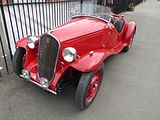
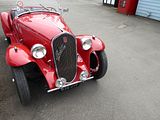
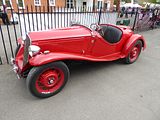

Next oldest Fiat at the event was a pre-war 500 “Topolino” models. Clearly a work-in-progress restoration, with work still to be done on the interior, this one had an extended rear body making it a real 4 seater.
Having been wowed by the sight of the 1600s Osca Cabriolet at the Bristol event the previous weekend, it was good to see not just this car again, but a number of its close relatives. These were 1500 Cabriolets, an update of the earlier Pininfarina styled 1200TV Cabriolet, but with the more powerful 1500cc engine under the bonnet. The 1600 sports an OSCA engined twin cam of 1,568 cc, which develops 90 PS. It was available at the same time as the 1500 Cabriolet, which was from 1961 to 1966, and can easily be distinguished from the 1500 model by its additional lamps at the outer corners of the grille. The owner of this car only got it late last year. The car was first sold to a buyer in Italy, but then was moved to the US where it lived until 1996, at which point it returned to Italy. It turned out to be a very solid car indeed, needing very little work done to it, though it has been treated to new leather seats, replacing the original vinyl items. To my eyes, the simple Pininfarina styled lines of this car are just about perfect from every angle.
Fiat launched new large cars, the 1800 and 2100 in 1959. Styled by Pininfarina, they looked not unlike the Peugeot 404 and the BMC quintet of Austin Cambridge, Morris Oxford, Riley 4/68, Wolseley 15/60 and MG Magnette. A facelift in 1961 brought a bigger engine, creating the 2300, and there was also an elegant coupe model added to the range. A stunning example of that car, the 2300S Coupe was parked up here.
The Nuova 500 was launched in 1957, and was then produced, in vast quantity for almost 20 years. Survival rates are high, with cars continually reaching this country from Italy where the dry climate has helped to protect the little car from rust. Can there be any small car that brings more a smile to people’s faces than this? It seems to have universal appeal, with its cheeky cute looks and the very distinctive sound of the flat twin tucked away at the back of Dante Giacosa’s legendary design. There were a number of these little gems parked up under some of the planes. It was well into the afternoon before I got to this area of the venue, and as I did, cars were starting to depart, so no doubt I missed some of these little cars, including, sadly one of the rare Giardinetta estate models, but I as in time to find all these.
Parked up with them was one example of the slightly larger 600. Pre-dating the Nuova 500 by a couple of years, this car was only sold in the UK until 1964, though it continued in SEAT guise in Spain well after that, which is why there are so many of these cars to be seen there.
Fiat launched the 850 in 1964, as a replacement for the 600. A slightly larger car, with a bigger and more powerful engine, it was the perfect car for the time, as by the mid 1960s, customers had that bit more money to spend on something that was not quite so small and basic. As well as the regular saloon model, a very pretty Coupe and an open topped Spider were offered. The last of these was never sold in the UK, though a number have now reached our shores, and a couple of them were on display here. The Coupe was sold here, and was very popular in the day. Rust has claimed most of them, so it was nice to see a number here, including a couple of early cars with the straight-down rear end before Fiat modified it with a slight lip in the upper surface of the engine cover and twin rear light units. There was also one of the rare saloon models shown.
This 1200D Saloon was departing just as I arrived in the area, so I only had time to grab a couple of quick photos. The underlying design, launched as the1100, dates back to the early 1950s, but a series of styling updates kept it looking reasonably contemporary right through the 1960s, and mechanical changes saw the 1100 name become a 1200 for a while before the final 1100R cars.
I’ve long had a very soft spot for the Fiat Dino models. It would seem that the market has woken up to the charms of these cars in a big way in the last couple of years, as you would now struggle to find a Spider version in good condition for less than £60,000. Not unusually for the era, these open topped cars looked completely different from the Coupe model, though underneath both shared the same Ferrari 2 litre or later 2.4 litre engine and other mechanical parts. Italian elegance at its very best here.
The 124 Saloon of 1966 was quickly joined by Coupe and Spider models, as well as practical Estate car. It is the sporting ones that you tend to see these days, and sure enough there was one first generation Coupe and a few of the later Spider cars which were here.
Looking not unlike the 124 Saloon which was launched a year earlier, the 125 was actually based on the platform of the old 1300/1500 Saloon but it sported a potent 1600cc Twin Cam engine under the bonnet, to create a rival for cars like the Ford Corsair, Vauxhall VX 4/90, Renault R16 TS and BMW 1800 Saloon. A more powerful S model was added to the range in 1968. Although the body shape lived on well into the 1990s in Polish FSO guise, the Fiat was replaced in 1972 by the 132, so it is a very rare car these days.
I saw a white 128 Estate model drive onto the site, but never caught up with it again during the day, which is a shame, as Estate versions of Fiat’s former Car of the Year are particularly rare. Not that the saloons are much more common. Two of those were present, The blue one used to belong to Auto Italia photographer Michael Ward, and would appear to still be in good hands these days, and there was a rare race version of the model. The initial Coupe model, unrepresented here, was replaced after a short production run by a Hatch car, the 3P and there were a couple of these on show, both of which were the limited edition Berlinetta cars of 1979, produced, it has to be said, to help to shift a backlog of stock.
Many of the mechanical parts of the 128 were used on Fiat’s lovely little mid-engined sports car, the X1/9. Launched as a production car in 1972, having been adapted from a concept shown in 1969, this car quickly became seen as a cut-price Ferrari, a soubriquet used by Autocar magazine’s Peter Windsor when he ran a long term example in 1977. The car was produced until the mid 1980s, though the final cars were badged Bertone, and it seemed as if Fiat lost interest in it, as after the 1978 faclieft which brought a more powerful 1500cc engine, and larger bumpers, it was only a number of now rather desirable limited edition versions which kept the car fresh. That does mean that there were a number of versions, and there were examples of most here, with one of the UK Launch Editions with its side stickers in the scallops down the side of the car, the Lido and then the later VS as well as one of the last Gran Finale cars.
Replacement for the 128 was the Strada, a car that was initially advertised as being largely built by robots. That did not stop the cars rusting though, and most of these distinctive looking cars have long since left our roads. Most of the survivors are the sporting versions and indeed that is what was present here. A late model 130TC, Fiat’s hot hatch that was more potent than the Golf GTi and Escorts of the era, had a prominent position in the centre of the event. Later in the day an example of the warmed up version, the 105TC, was also on site, though it drove off just before I got to it with my camera.
One of my favourite cars of the day was this lovely 130 Berlina. Fiat decided to build a large car, to replace the 2300 range, and showed the result in 1969. A stylish Coupe model followed a couple of years later and this is the one that you see more frequently these days. Surprisingly, there were no 130 Coupes present, but this splendid Berlina more than made up for that.
The rear-engined 126 was an update of the popular 500, but even though it arrived just as the 1973 Oil Crisis made economical cars particularly popular, it never quite captured the affection enjoyed by its predecessor. The initial cars were made in Italy, but thanks to the tie up with FSO in Poland, later models were all made there, where the car was the best seller on the market for a long time. A hatchback and a water cooled and slightly more powerful engine created the 126-Bis, which is what this one is.
The 131 Mirafiori was launched in 1974, as a replacement for the 124 range. A conventionally engineered family car, it competed against the likes of the Ford Cortina and Morris Marina, but that rather boxy styling hid twin cam engines and five speed gearboxes which made the Fiat rather more of an enthusiast’s car than the British products of the day. Initially quite popular, the car faded over time, despite two facelifts, which in my opinion did little to make the car look better. In late 1978 Fiat dropped the 2 litre 1995cc engine under the bonnet to create a fast saloon, called Racing on the continent, but in deference to British sensibilities, it was renamed Sporting for the UK market. By the time of the third generation cars, in 1982, the supercharged version of this engine was put under the bonnet, though these Volumex cars were never officially sold in the UK. In Abarth rally guise, the car was very successful in the forests. There are not many left now, so it was a real pleasure to see a significant number of these cars gathered together, with examples of each of the three different generations, and a mix of model types, from a Series 1 1600S to the Series 2 Supermirafiori, a couple of the Sporting cars as well as the later Series 3 models.
Fiat launched the Uno in January 1983, just one day before the equally iconic Peugeot 205. Both were huge sellers, and deservedly so too, but it was the Fiat that sold in greater quantity, with over 8 million examples produced. It was Italy’s best selling car, and by some margin, throughout its 10 year production life, though you might find that hard to believe now, as they were are not a common sight even in Italy. A number of examples were shown here, including a splendidly restored Turbo ie model which claimed a prize at last year’s Stanford Hall event, and deservedly so too.
Fiat were late to the Hot Hatch party, which had really got underway in the late 1980s, era of the Yuppie, the FiloFax and red braces. The raw ingredients were there, with the 1988 Car of the Year winning Tipo, but for the first three years of production, the fastest model you could buy had a 1.9 Turbodiesel engine under the bonnet. Finally, the Sedicivalvole, as the badging proclaimed, was added to the range in late 1991. Well regarded in objective terms, it was never a big seller, with the car perhaps being a bit too subtle looking. Despite being the first Fiat to use a fully galvanised body and lots of non-rusting plastic parts, most Tipos have long since been recycled but this red car was a splendid example. A three door model came even later, and there was an example of this as well.
If the Uno was credited with “saving” Fiat in the 1980s, then the Punto must claim the same achievement in the 1990s. Launched in mid 1993, this stylish B-segment hatchback moved the game on in terms of refinement compared to what had been on offer in he class. A Bertone-styled Cabrio was added to the range and there was a lovely example of that in the display as well.
The Punto platform was used as the basis of a very pretty sports car, the Barchetta, which was a direct rival to the MGF and Toyota MR2. Never made in right hand drive form, sales in the UK were not that strong, which is a shame, as in my opinion, this car looks better than its rivals.
Second and third generation Punto models were well represented, too.
Boldly styled by Chris Bangle, before he moved to BMW, the Fiat Coupe is one of those cars which became an instant classic. The combination of those dramatic looks, and a reputation for being good to drive, especially when the later 5 cylinder engines were squeezed under the bonnet, this car had lots of fans when new and its popularity has never really waned. Only produced between 1993 and 1999, and with a long delay in getting cars to the UK, the model had quite a short production life, but there are still over 1000 of them on our roads, so it was no surprise to find a significant number of them at this event. Bright colours suit the lines of the Coupe well, so they always make for a colourful sight.
The cheeky little Cinquecento and Seicento models were aimed at the demand for smaller city cars as the once entry level models that all manufacturers offered had grown ever bigger, leaving space in the range for a smaller car. It did not take Fiat long to boost the power of the 45 bhp Cinquecento, and fit lower profile tyres and stiffer suspension, calling the result the Sporting, and a pocket rocket, or roller-skate on wheels was born, that offered fun on an affordable basis to many. The same formula was applied to the follow on product, the Seicento. These days there is quite a following, with a lot of young owners enjoying the fact that these cars do not cost much to run, or insure, and are simple enough that they are easy to fix if needed.
In the mid 1990s, Fiat produced a series of mid-sized models. Bravo and Brava hatchbacks were joined by the Marea Saloon and Weekend (estate) models. I used to get these regular both as rental and courtesy cars and enjoyed them, even the entry level 1.2 litre 80 bhp petrol models. but a lot of them fell victim to scrappage, and there are surprisingly few of them left. Indeed, the only example that was present here, as far as I recall, was a nice Marea Weekend. Not quite as large as a Mondeo, this car occupied a sort of “in between” segment, which can be a difficult place, so sales of the Marea were not strong, but with the stonking 20 valve 2 litre petrol engine or the 150 bhp 2.4 JTD diesel under the bonnet, it went like the proverbial, and was a great car to drive. I was very impressed by the ones I drove., Shame that too few people appreciated it until it was too late.
Fiat have never been afraid of doing controversial, and in recent times few European cars have been as stylistically odd as the Multipla. Underneath the looks which no-one could ever say were in sense “beautiful”, though, lurked a supremely practical car. Three abreast seating, made possible thanks to the width, and that boxy styling and high roofline meant that this was an extremely roomy and practical car in a compact outer-casing. Top Gear even accoladed it as their Car of the Year back when it was new, and given their criteria, that really does mean that it had plenty of merit, even if visual appeal was not one of the strengths.
The Stilo was intended to combine the Latin flair with VW style quality. Unfortunately, the balance did not quite work, as in trying to make the car more refined, much of the brio that made mid-sized Fiats such fun to drive, seemed to disappear. Only the high end versions with the characterful 5 cylinder 2.4 litre engine, installed in the neatly styled 3 door body seemed to capture anyone’s imagination. There were a couple of them here, including one of the Schumacher Edition cars.
Stilo was followed by Bravo. Looking rather like an enlarged Grande Punto, and offered only as a five door hatch, this car failed to enthuse the market, and it has gradually faded from view. That’s a shame, as the more potent ones, such as the 150 bhp T-jet top of the range were really rather good to drive, and nicely finished.
The second time that Fiat used the Croma name, it appeared on a car which shared its underpinnings with a GM model, specifically the Opel/Vauxhall Signum. Codenamed Tipo 194, and sometimes known as “New Large”, the result was a very roomy car that in paper must looked like just what the market wanted, but in practice, it failed pretty dismally. It was actually not a bad car, with lots of space and a particularly relaxed gait to it, but even after the slightly anonymous looks of the first version had been “Punto-ified” with a facelift, sales were slow and the car faded from the market. The local taxi firm bought a lot of them, so I used to see plenty for a while, but they are long since moved on, and these days a Croma is quite a rare car, so it was a surprise to see a couple of them here.
Now onto its third generation, the Panda has proved to be a big success for Fiat. The first one, launched in 1980, is said to be designer Giorgio Giugiaro’s favourite design of the many cars that he styled, and these cars can still be seen in active service all over rural Italy. Initially a deliberately basic hatch, with hammock style seats, Fiat offered a number of limited editions, with bold colours and designer labels attached, as well as striking gold with the little 4×4 version, which proved particularly popular with buyers in mountainous areas. The second generation car, which nearly ended up with the name Gingo, until Renault complained, was a huge hit, as well. The third generation car had a seemingly slow start, but this model, with its “squircles” is now a frequent sight everywhere, with a certain classlessness to it which means it is just as at home in the city, the country and a posh venue as well as in workhorse mode. There were examples of all three generations here, ranging from a first generation 1000S and 4×4 Sisley to several of the potent little 100HP second generation cars and the latest Cross and 4×4 cars.
There are now well over 200,000 of the current Fiat 500 on UK roads. This retro-styled car has really captured a place in the hearts of many, and so it is no surprise that there were plenty of Fiat (as opposed to the Abarth) versions here, with 500 and 500C models and several of the different trim versions offered all on display.
The 500L is now a common sight on our roads. Once again, Fiat have prioritised function over form, as this car, despite the styling allusions to the much loved 500, is not going to win prizes for its beauty. But it is spacious, and practical, which is exactly what plenty of people are looking for these days.
Bringing things right up to date was a 500X, a new model which only went on sale at the start of May. Sharing its underpinnings with the very different looking Jeep Renegade, this crossover design represents Fiat’s latest effort to tap into a market that continues to move away from the conventional hatchbacks that have been so popular over the past 40 years or so.
ISO
Oiginally founded in Genoa in 1939, but transferred to Bresso in 1942 by Renzo Rivolta, an engineer and the heir of industrialists, the Iso Rivolta company was initially named ‘Isothermos” and manufactured refrigeration units before World War II. After the Second World War, the company reopened its doors, completely changing its activity. In 1948 it began to build motorcycles, scooters and motocarries (three-wheeled transport scooters/motorcycles). Among the most famous are the Furetto (1948), ‘Isoscooter (1950),’ Isocarro (1951), ‘Isomoto (1954) and’ Isosport (1953). Accordingly, the business was refounded as Iso Autoveicoli S.p.A. in 1953 to reflect the production of motorized transport. In the mid-1950s, Rivolta started to develop a miniature car for two persons and front entrance, initially with only three wheels, later, for reasons of stability, with four wheels (the two on the rear very close together): the Isetta Bubble Car. About 20,000 of the bubble cars were built at the Rivolta works near Milan. Starting in 1954, Isetta was licensed to automobile manufacturers in several countries: France (by VELAM), Spain, Great Britain and Brazil (by Romi). The most successful, however, was the German Isetta built by BMW. The BMW-Isetta went on to dwarf the production volumes of Rivolta and fulfilled the dream of mobility in post-war Germany. About 130,000 had been sold by 1962. That success encouraged Rivolta to become more ambitious, and together with engineer Giotto Bizzarrini, designer Giorgetto Giugiaro and chassis builder Bertone, Renzo Rivolta began developing the Iso Rivolta IR 300, which was first presented at the Torino Show of 1962. It was an elegant 2 + 2 Coupé with well-balanced technical components and outstanding driving performance. It had a 5.4 litre V8 Chevrolet Small-Block engine, the transmission came from General Motors in Detroit, and the de Dion suspension and four-wheel disc braking system came from the large Jaguars of the time. This concept was maintained for almost all production cars of Iso. The cars sold steadily. but in small numbers. There was a very nice example on display here.
Iso Rivolta’s most well-known Gran Turismo automobile was the Iso Grifo which featured a low-slung, sporty berlinetta body by Bertone. After Bizzarrini left the project, this prototype formed the basis for his own Bizzarini 5300 GT. The Grifo Prototype was further refined by Iso, receiving a reworked, less aggressive and more luxurious body in the process, and went into production in 1965. The Grifo was powered by Chevrolet´s 5.4 litre V-8 producing either 300 or 350 hp. In 1966 a convertible version of the Grifo was shown, but never reached production. Starting in 1968 the Grifo was also available with Chevrolet’s 7 litre big-block V-8; this version was easily recognized by the broad air inlet on the hood. Later-day Grifos, the Series II, featured concealed headlights and a slightly modified front area. The Grifo seen here is a 7 litre model.
Meanwhile, Renzo Rivolta had died in 1966, and his son, Piero, had taken over as managing director. Under Piero’s leadership, Iso built the limousine Fidia, “the fastest four seats on wheels” (according to a 1967 advertisement) with body by Ghia, the Grifo 7 litre (with the GM V8 7 litre marine engine) and the 2 + 2 fastback Coupé Lele (1969) with body designed by Bertone, intended as the successor to the IR 300. At the start of 1973 the Rivolta family ceded the business to an Italian American financier named Ivo Pera who promised to bring American management know-how to the firm. The business was again renamed to Iso Motors, just before fading rapidly into obscurity, going bankrupt in 1974, only 1700 Iso Gran Turismos had been built in those ten years. That meant that the Lele was the last new design offered. Styled by Bertone, there was little wrong with the looks of the car, but build quality was patchy and the large V8 engine was thirsty so when the fuel crisis of 1974 made such cars a liability, sales reduced to next to none, and this proved the deathknell for the marque. There were a couple of Fidia models on show, one of which was at one time owner by John Lennon as well as a striking bright red Lele.
LAMBORGHINI
It was well into the day before I got to the area where the Lamborghinis had been assembled, and I suspect that a few could well have come and gone. Certainly there were a few here which eluded my camera, as seeing cars like an Espada and a bright green Huracan with a large crowd around them, I vowed to return, and found that they had departed the event. Even so, there were plenty of these dramatically styled cars to look at, and to present here. Oldest Lamborghini in attendance was this Islero. Produced in the late 1960s, this was effectively the successor to the 350/400GT models which marked the start of Ferruccio Lamborghini’s venture into car production. Featuring a V12 engine (of course), this 2+2 GT car was only produced for 2 years, during which time 225 units were made.
The Jarama first appeared in 1970, as the replacement for the Islero Another fast four seater, 327 of these were built over a 4 year period, 70 of which were the S model, like this one, which sported a revised interior.
Which small boy (and perhaps car loving girl) did not lust after a Countach back in the 1970s and 1980s. A dramatic looking car, this was the stuff of dreams that you would only ever see at the London or NEC Motor Shows. Countach first made an appearance, as a concept in 1971, but it was 1973 before the production car made its debut, and despite unfortunate timing with fuel shortages and a recession, and a number of financial problems for its maker, the car sold well throughout its production life. The car was updated a number of times during its lifetime, with a larger and more powerful 5 litre engine being fitted, in an attempt to stay ahead of rival Ferrari. This is one of those LP5000S cars. Incidentally, LP stands for Longditudinale Posteriore, in other words nothing more exotic than the location of the engine, an orientation that has featured in every Lamborghini since. The Countach stands at little more than 1 metre tall. No wonder they were so hard to get in and out of!
By the early 1970s, Lamborghini had been toying for some time with the idea of a smaller and cheaper car, powered by a V8 engine, to rival the smaller Ferraris, and the result – badly timed thanks to the 1973 Oil Crisis, was the launch in 1974 of the V8 powered Urraco. A low powered 2 litre version was produced to meet the challenges of Italian tax law, but other markets saw cars with bigger 3 litre engines. In 1976 the car was altered to become the Silhouette, which had a lift out targe top panel, and a number of other styling changes. One of these was on display, along with the car which it mutated into, the Jalpa. Launched in 1982, this model had a larger 3.5 litre V8 engine and further revisions to the styling. 410 cars were sold, making it the most successful V8 Lamborghini there has been.
After several false starts at creating a replacement for the Countach, a new car finally appeared in 1990, the Diablo. This even more dramatically styled car sold in greater numbers, with the 1000th car being produced after only a few years, and 2898 cars beating the Diablo name were made in total. A number of different models were offered during the 11 year life of the car. A number of these cars were on show, including the SV version.
In its turn, the Diablo gave way to the Murcielago in 2001. By this time, parent company Audi’s money was being made available, and this was reflected in higher standards of build quality, though the Lamborghini trademark bold styling remained, and the noise of the thunderous V12 remained a feature of the car throughout its 10 year life.
The Gallardo was launched in 2003, and stayed in production over 10 years, In excess of 10,000 were made, making it by some margin the most popular Lamborghini yet made. During the long life, lots of different variants were produced with a mixture of all wheel drive and rear wheel power only, open topped bodies, and lightened Superleggera models. Several different ones were on show here.
The Aventador came in 2012, to take the place of the Murcielago, and it remains every inch a true Lamborghini, with bold looks and an awesome sound track from its 7 litre engine. There were a couple of these on show.
Newest Lamborghini is the Huracan, a replacement for the Gallardo. There were a couple here, though a bright green one eluded my camera. I suspect that over time, as more variants appear, the car will get wilder and with a shoutier appearance. It is almost a bit too mild looking to be seen as a true Lamborghini for now, though I am not sure that the Oakley Design treatment is the answer.
LANCIA
Oldest Lancia, indeed the only pre war example of the marque, was this Aprilia. Made between 1937 and 1949, this was one of the first cars designed with the help of a wind tunnel. Lancia cars of the era were engineered to the highest standards and this V4 powered saloon was no exception, with lots of details which made it feel very special compared to rival products of the day.
The Aurelia first appeared in 1950 as an elegant and costly saloon model. An elegant Coupe was added to the range soon after, and this is the car which is generally believed to be the first to adopt the much used and abused GT moniker. There were examples of both here, a B10 Berlina and B20 GT
Smaller brother to the Aurelia was the Appia. Engineered to the same exquisite standards as the larger cars, which made them expensive, the Appia featured a small capacity V4 engine under the bonnet. A number of different body styles were offered, in addition to the regular Berlina. This is a Series 3 model.
The Appia was replaced in 1963 by the Fulvia. A front wheel drive car, like the large Fulvia which preceded it by three years, the first models were V4 engined Berlina models. A very pretty Pininfarina styled Coupe was added to the range, and this probably the best known body style of the model these days. Zagato also produced an exclusive and expensive version, which was known as the Sport, and there were examples of this as well as several of the Coupe models in all three Series and a Berlina.
The Stratos is one of those cars which needs little introduction. The first car that was purpose designed for rallying, Bertone’s shape is as striking now as it was over 40 years ago when first revealed.
Mainstay of the Lancia range throughout the 1970s was the Beta. A front wheel drive saloon at launch, the range was soon expanded to include a very attractive Coupe, the 3 door HPE and an open topped Spider. Two of the four body styles were represented here, with Coupe and Spider models present.
Related to the Beta, through the use of its mechanical parts and chassis, but with a mid engine in place of the front placement of the Beta, was the MonteCarlo, a car that was initially conceived as the Fiat X1/20, but which gained Lancia badges not long before its 1975 launch. Early cars had a reputation for locking the brakes very readily, and some interesting handling characteristics, both of which were addressed in the Phase 2 cars that went on sale in 1981. The car did not last long after this, though.
The Delta started out as a luxurious hatchback, offered in 1300 and 1500cc guise. More power came first with a 1600GT version in 1983, and then, every year saw a more potent model added to the range. The first HF Turbo came in 1984, and four wheel drive was added in 1986, opening the door for what would become a legend, the HF Integrale. This modestly sized car, with a well sorted chassis proved to be just the car that Lancia needed for honours in the forests, rivalling the legendary Audi Quattro, and to homologate the cars that they want to take rallying, they had to make changes to the road cars. Ever more powerful cars, with a wider track for better handling then appeared throughout the rest of the 1980s and into the early 1990s. The fact that the Integrale was only available with left hand drive was no impediment to sales, as there were plenty of people who want the road-going version of a car that the likes of Markku Alen and Mikki Biasion hurtled around the forests of the world. Nice condition Integrales are popular even today, and there were lots of cars in this category on show here, along with the far rarer 1300LX model that started it all.
The Thema was Lancia’s version of the Type 4 project, which also produced the Alfa 164, Fiat Croma and Saab 9000. The Lancia was a conservatively styled three box saloon, offered initially with a choice of Lancia’s 2 litre 4 cylinder engine, in injected and turbo guises, as well as the 2.8 litre V6 Douvrin unit. Later the Ferrari engined 3.2 litre V8 model was created, and a low volume Estate car was added to the range, although this was never offered to UK buyers. A facelift in 1990 changed the front end styling, and updated the trim and mechanicals. There were a couple of Themas here, both of them the facelifted model.
Although the Y10 was badged as an Autobianchi in Europe, in the UK it bore Lancia badges. A luxuriously trimmed and finished city car, based on the Fiat Panda, this diminutive machine was sold from 1985 for nearly 10 years, and it came in mild (45bhp from a 903 and later 999cc FIRE engine), to the wild Turbo cars. There were a couple of examples shown here, with an early car contrasting with the later and slightly facelifted one.
MASERATI
Launched in 1971, the Bora was a veritable supercar. Lacking the really dramatic looks of rivals from Ferrari and Lamborghini, the appeal of this car was perhaps a little more subtle. That means that it has not enjoyed the massive increase in values of its rivals, but be in no doubt, this was a car to hold in Top Trumps when new, and one still to covet these days. The body, which was also adapted to create the 2+2 Merak, was created by Giorgetto Giugiaro for Ital Design, fabrication of the all-steel panels being contracted to Officine Padane of Modena. Two engines were offered initially, including a high-revving 4.7-litre V8 and a higher torque 4.9-litre V8. Eventually, production switched to using only a more powerful version of the 4.9-litre engine producing 320 hp at 6000 rpm. All these engines traced their lineage back to the famous 450S racecar, were aluminium alloy, had hemispheric combustion chambers with 16 valves operated by four chain-driven cams and fed by eight Weber carburettors, fired by electronic ignition. The extraordinarily competent and strong ZF-1 five-speed trans-axle was used, as it was with the GT40, Pantera, BMW M1, and other supercars of this era. Regardless of engine size or modification level, the Bora was considered an extraordinarily powerful car in its time. A combined steel monocoque chassis and body featured a tubular steel subframe at the back for the engine and transmission. Suspension was independent all round (a first for a Maserati road car) with coil springs, telescopic shocks and anti-roll bars. The development prototype and the broadly similar show car first seen at the 1971 Geneva Motor Show featured MacPherson strut based front suspension, but this was abandoned for production because, installed in combination with very wide front tires and rack-and-pinion steering, the strut-based solution produced severe kickback. For the production cars Maserati reverted to a more conservative wishbone front-suspension arrangement. Citroën’s advanced high-pressure LHM hydraulics were adopted to operate the ventilated disc brakes on the main circuit, and on an auxiliary circuit the pedal box [clutch, brake, foot-throttle], the driver’s seat [vertical adjustments], and the retractable headlights. Wheels were 7.5 x 15″ Campagnolo light alloy rims with distinctive removable polished stainless steel hubcaps in the earlier automobiles, and tyres were Michelin XWX 205×70 front and rear, however these early cars exhibited problems with “tramlining” at speed. To solve this problem Maserati fitted later cars with 215×70 Michelins’. Great attention was paid to reducing noise and vibration, the engine and five-speed ZF transaxle being mounted on a subframe attached to the monocoque via four flexible mounts. Most supercars offer little foot room and little to no provision for luggage, but the Bora has a full-size boot in the front of the vehicle, and was otherwise known as being much more civilized in comforts from its competitors, while still being capable of 171 mph. Unlike its competitors, the Bora used dual-pane glass separating its cabin from the engine compartment as well as a carpeted aluminium engine cap, greatly decreasing the engine noise in the cabin and increasing the comfort level for the driver.
Equally desirable is the very stylish Khamsin. Named after the Saharan wind, this glamorous GT was the first Maserati to be created in the Citroen era. Around 350 of them were made between 1975 and 1981.
Maserati replaced their entire range in late 1981 with the Biturbo. Aimed at a different market segment than the exclusive and expensive Grand Tourers which had constituted the company’s offerings ever since the start of road car production, the early cars were not particularly well received, and build quality issues soon became apparent, compounding the challenges of getting them accepted as truly desirable. Over the following years, a wide range of models were produced, with a 4 door body and Zagato produced open topped Spider being joined by models with many different engines, meaning that you really need a marque expert to help you to sort out what you are looking at. The only BiTurbo car per se that was present was a 222E, a relatively late model Coupe version.
In 1994, the Biturbo was updated significantly, and the result dusted off one of the respected names of Maserati’s past, the Ghibli. Sometimes referred to as Ghibli 2 to distinguish it from what went before, these cars were pretty well sorted, and a nice example of these would be an interesting classic to own.
The Biturbo variant that I would really want, though, would be one of the V8 engined Shamal models. A couple of these highly desirable cars were parked side by side.
Successor to the Biturbo generation of cars came with the launch of the 3200GT in 1998. A stunning design, admired by just about everyone, this car really put Maserati back on the proverbial map, and it was produced in significant quantity, before receiving a larger engine and upgrades to create the 4200GT. An open topped Spider model was a popular addition to the range.
There have been few more elegant looking saloons than the fifth generation Quattroporte, which was produced between 2003 and 2013. A couple of these cars were on show, one of which was in the rarely seen colour of white.
In 2007, Maserati presented a new style for the high end Coupe and Convertible cars, and there were examples of both of these, the GranTurismo and Gran Cabrio on show.
NOT QUITE ITALIAN
Despite an Italian sounding name, the Bugatti EB110 is not an Italian car. But who’s going to tell the driver of a car like this to park in the public car park? Just 139 of these stunning looking machines were made between 1991 and 1995. The car took its name from the fact that it was launched, in Paris, exactly 110 years after the birth of Ettore Bugatti. Styled by Marcello Gandini, the EB110 had a 60-valve, quad-turbo 3.5 litre V12 powering all four wheels through a six-speed gearbox. Acceleration to 100 km/h took 4.2 seconds, and the GT has a top speed of 213 mph. The car uses a double wishbone suspension, with the chassis built by Aérospatiale, an aircraft company, and made from carbon fibre. Equipped with Gandini’s famous lifting scissor doors, it has a glass engine cover that provides a view of the V12 engine along with a speed-sensitive electronic rear wing that can be raised at the flick of a switch. The gearlever is placed closer to the driver so that less time is taken to change gears. Five pre-production prototypes with aluminium chassis were built, followed by eight with composite chassis. Following these, it is believed that only 95 GT and 31 SS production models were constructed. In 1992, a lighter and more powerful model which generated 612 PS at 8250 rpm, the EB110 SS (SuperSport), was introduced. This car is capable of 216 mph (348 km/h) and 0-100 km/h (62 mph) in 3.2 seconds. The company ran out of money in 1995, entering bankruptcy, though the remaining chassis were acquired by German organisation Dauer Racing GmbH who did eventually complete the cars, several years later.
And finally, having stunned the crowds last year, there was another appearance of this amazing machine, Il Drago Ruggente (the Roaring Dragon). Built on a 1924 Delage chassis, it has a 27 litre aero engine to power it.
2015 marks the 25th anniversary of the publication of AutoItalia magazine, a pre-eminent publication for lovers of the sort of cars that you have now seen in all their glory in this report, and edited throughout all that time by the ever enthusiastic Phil Ward. Ably assisted by his photographer son, Michael, and a team of others, his GingerBeer promotions company pulled off what is surely going to be remembered as one of the event highlights of the year, and a fitting tribute to all that Phil and his team have done to keep these fantastic machines so much in the hearts and minds of so many people in the UK. A truly epic day.

